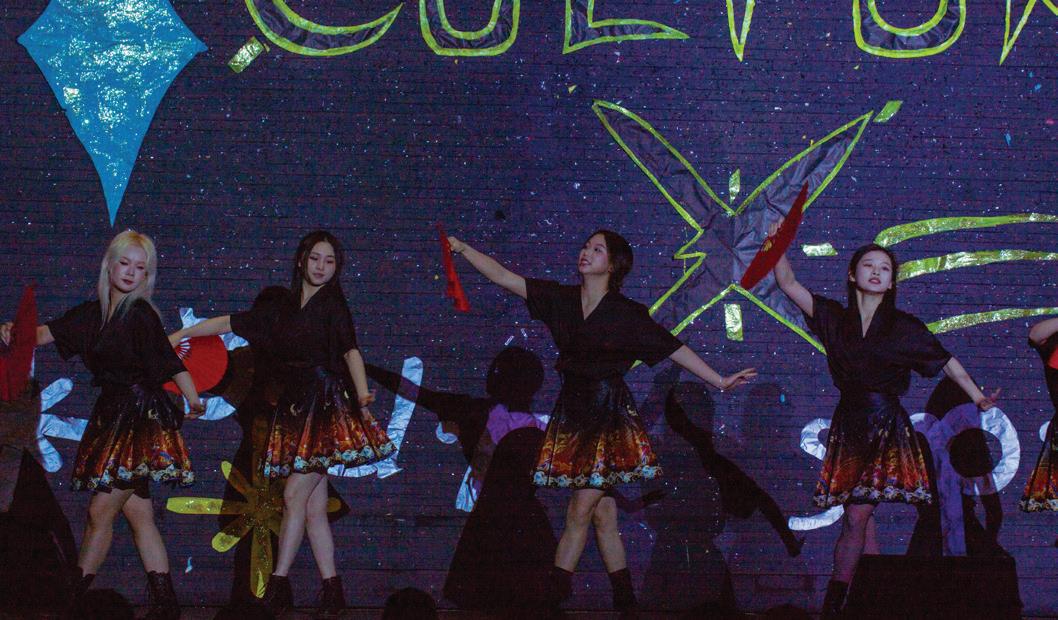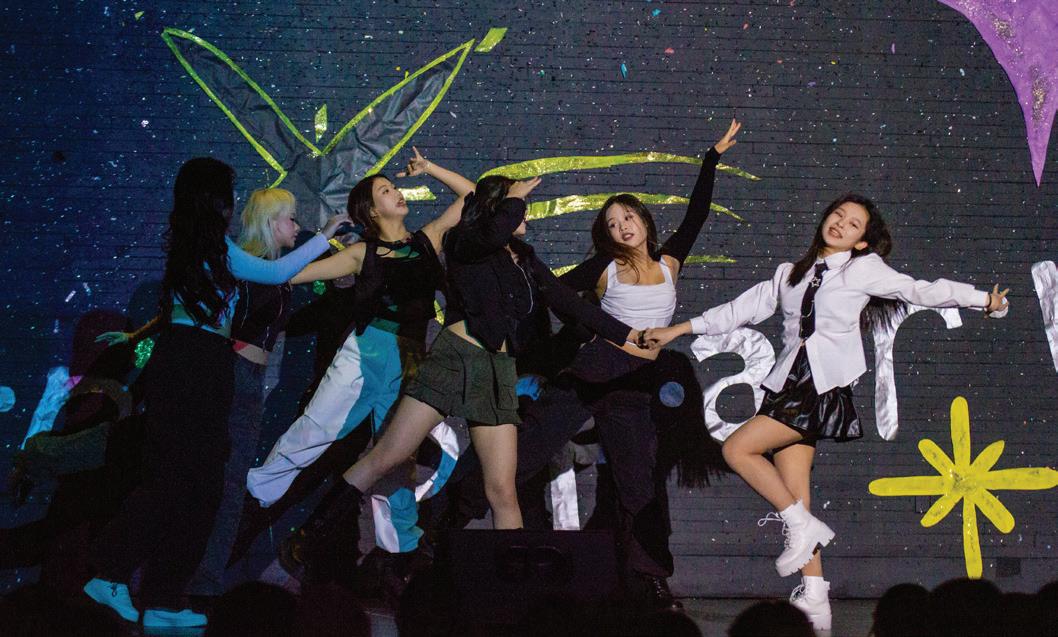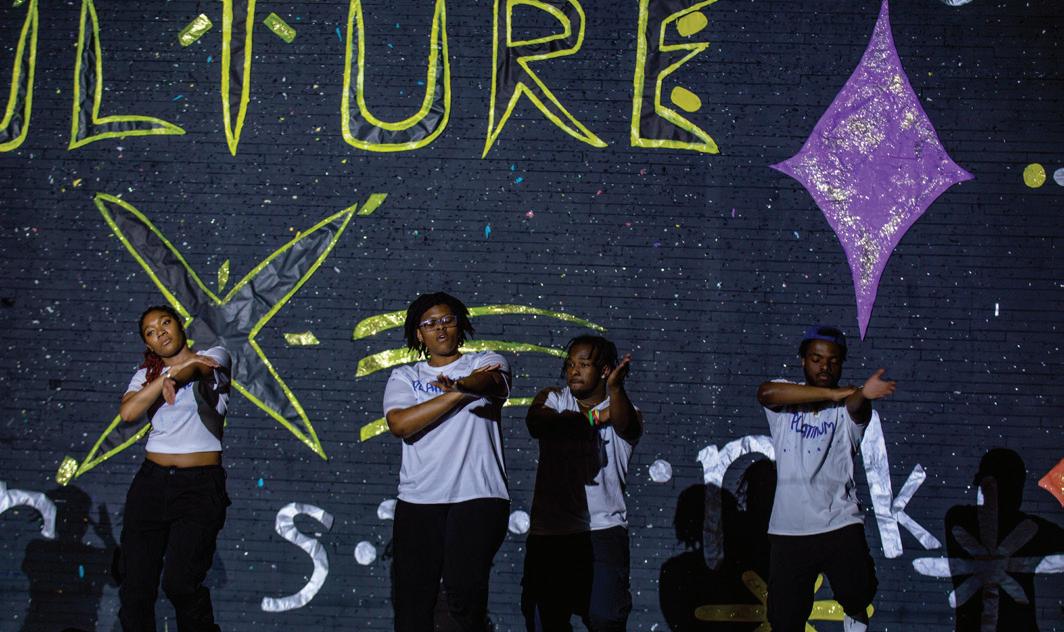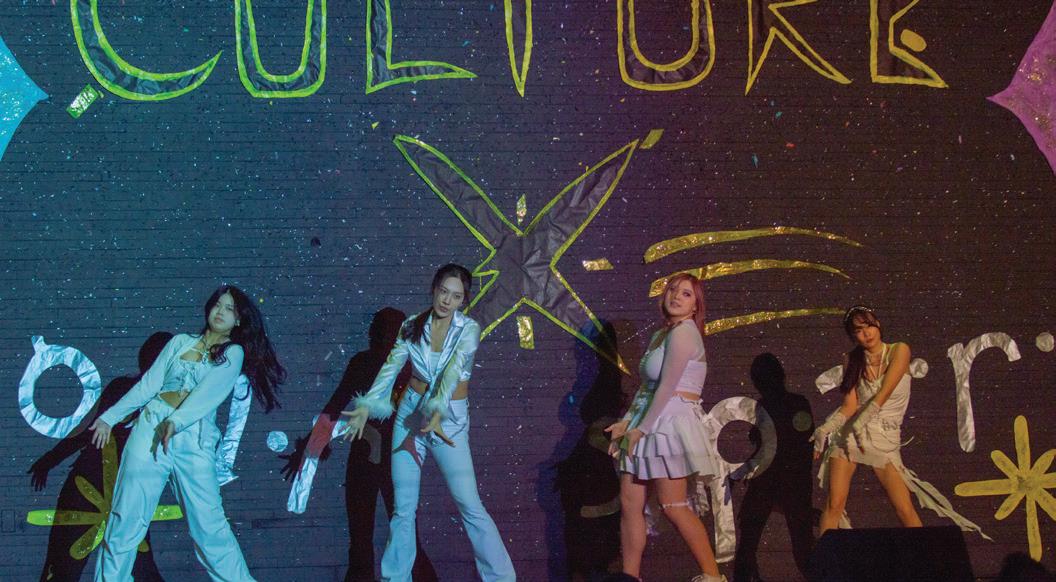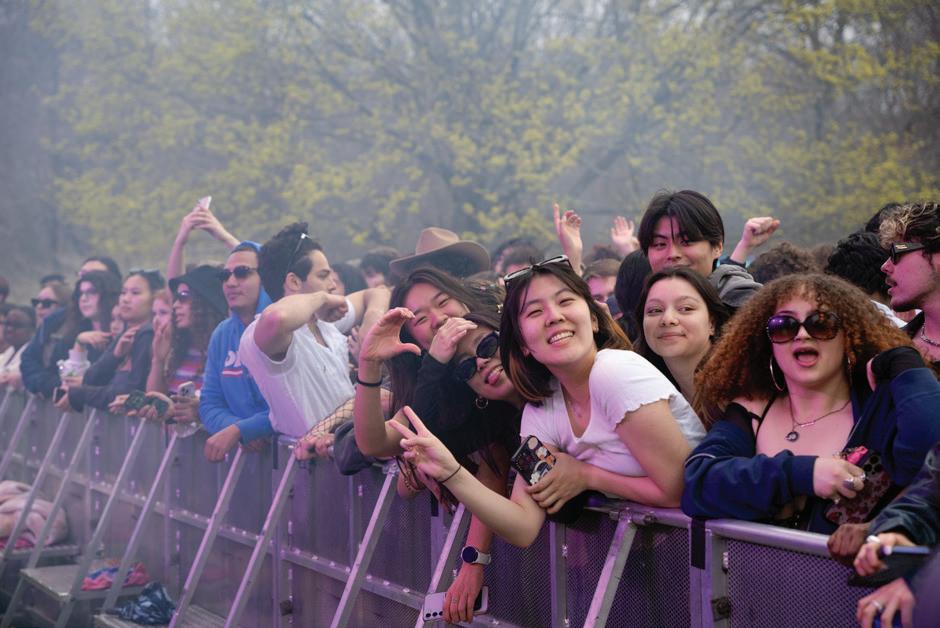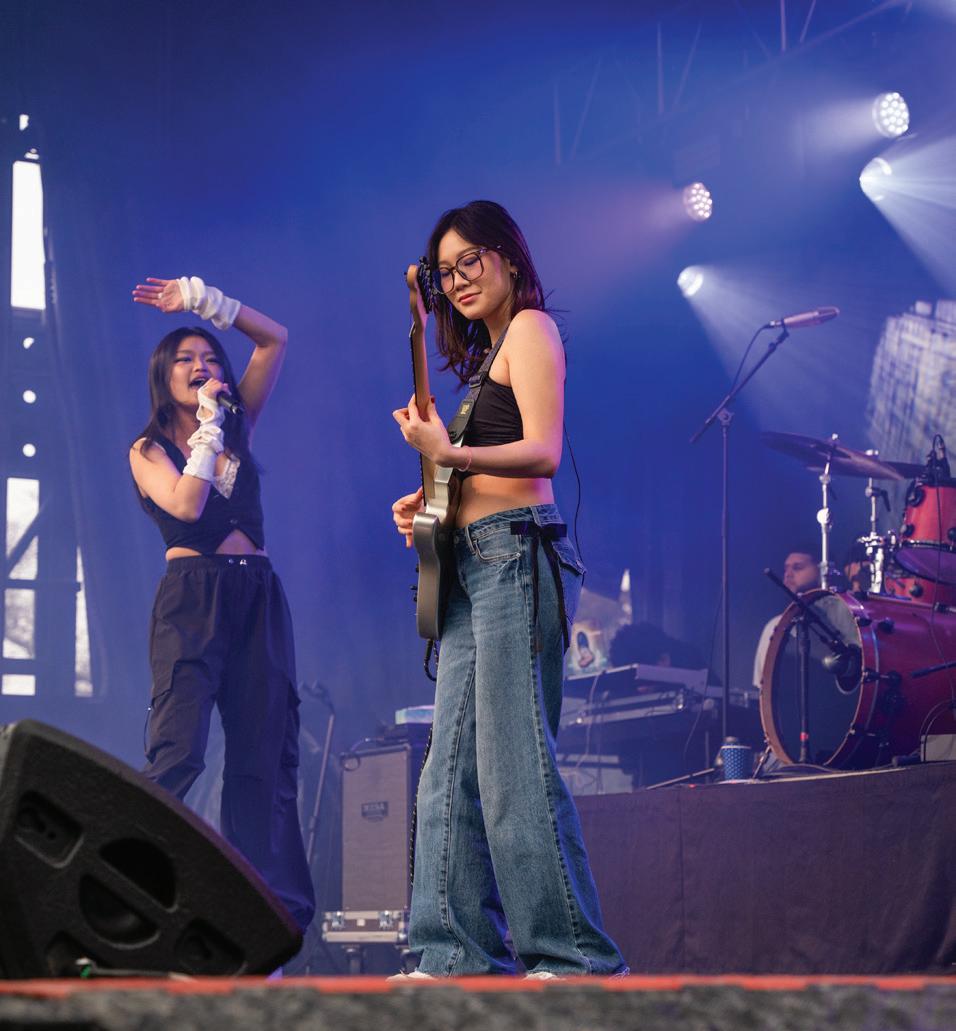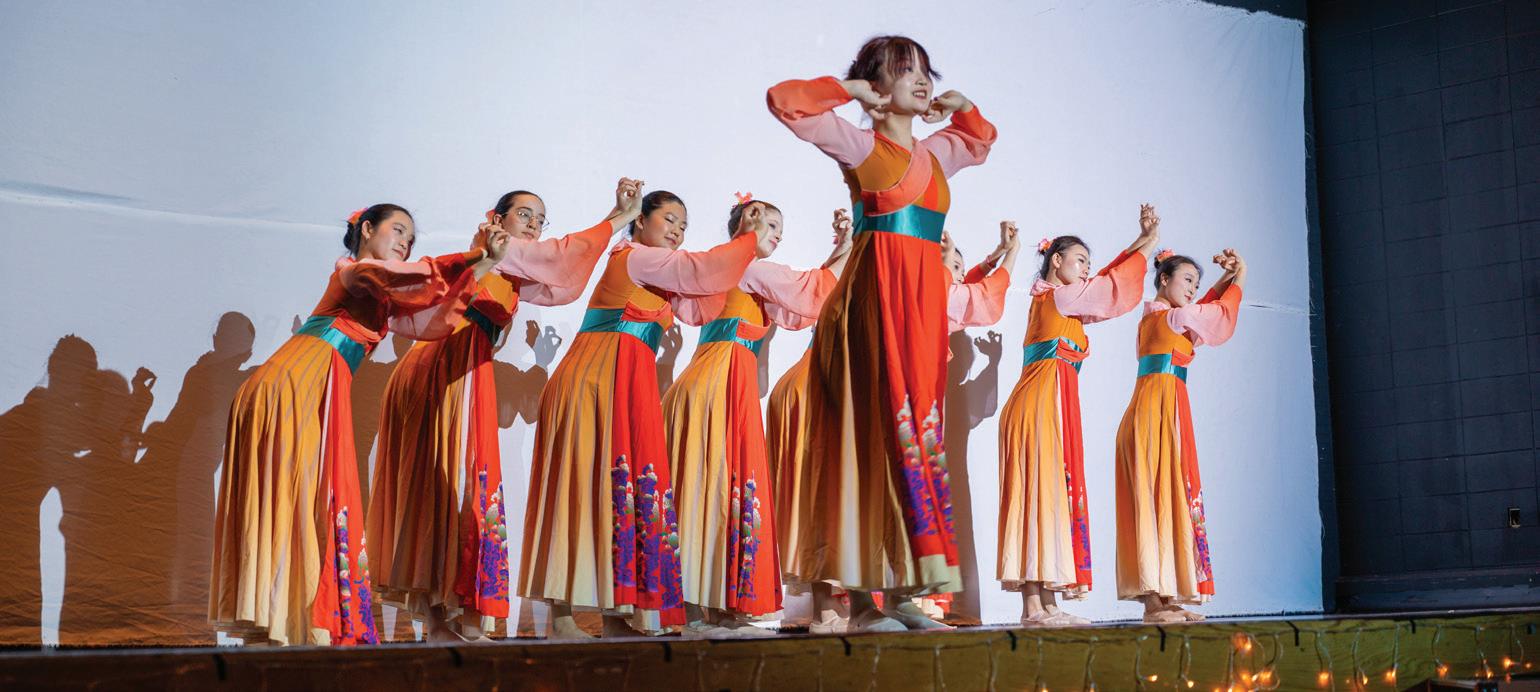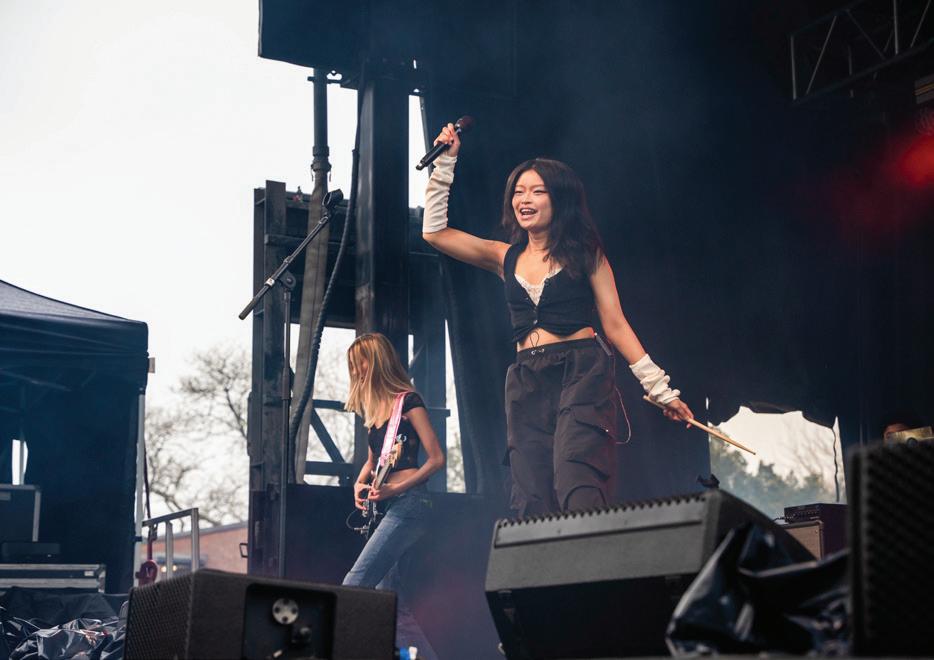




■ The independent investigation report following the arrests of Nov. 10 was just released, garnering responses from the community.
By ANNA MARTIN JUSTICE EDITOR IN CHIEFOn Tuesday, April 9, the University community received an email from Executive Vice President for Administration and Finance Stewart Uretsky and Provost Carol Fierke. This email shared the completed report compiled by independent investigators from the law firm of Hirsch Roberts Weinstein that reviewed the Nov. 10 arrest of demonstrators protesting the derecognition of the Brandeis chapter of Students for Justice in Palestine.
According to the email, “the investigation reviewed actions taken by Student Affairs and Brandeis University Police Department with respect to the day’s protest, and made recommendations where opportunities existed for policy or procedural improvement to align with best practices in higher education.”
The report explains that the protest took place on the Great Lawn for 30 minutes before the chants of the phrase “from the river to the sea, Palestine will be free” began — a phrase that had been banned earlier that day when it was classified as “threatening and harassing speech” by the administration. According to the report, some of the individuals utilizing this phrase were not Brandeis community members. A representative from administration then spoke to a gathering organizer, “[advising] that those chants violated the University’s prohibition calls for violence against others.” The organizer was advised that if the chants continued, “the protest would be required to end.”
Upon continuation, the administration representative determined that protest dispersal was necessary. According to the report, law enforcement present called for the dispersal of the crowd four times, but the protesters did not comply. One of the organizers of the event refused to disperse and was placed under arrest. According to the report, while this arrest was occurring, two more arrests took place when the individuals detained threw liquid and punches at the officers. While attempting to transport these individuals to a vehicle for transport to the station, others “interfered with police efforts and/or, in the case of nonaffiliates, refused to leave campus.” They were ultimately arrested as well.
Two interviews were conducted through the process of this independent investigation. The subjects of these interviews were Chief of University Police Matthew Rushton and University Vice President of Student Affairs Andrea Dine. The report

states that Dine was the university administrator on scene at the time of the protest.
The independent investigation also consisted of a community listening session held on Feb. 2. This session was conducted by the faculty senate and a redacted transcript was provided to the reviewers on Feb. 7. The members of this session were undergraduate and graduate students, faculty and members of staff.
This transcript was considered by investigators along with a list of other items as seen in the report. These included “Department of Student Rights & Community Standards, Section 7; Campus Protests and Demonstrations Rights and Responsibilities Department of Student Rights and Community Standards Brandeis University; Brandeis University Police Department Use of Force Policy; Brandeis University Police reports; Waltham Police reports; Closed Circuit Television Footage; Social Media Videos; Web Pages” and more.
The report illustrates that Dine expressed that while it is not required for students to inform administration of protests in advance, it is recommended that they do so. This allows the University to complete three main objectives: “to assist in planning to facilitate safety for demonstrators exercising their speech rights,” “to assist in planning to facilitate bystander safety and protection of property” and “to assist University affiliated demonstrators to navigate compliance with the University’s protest requirements.”
The report goes on to outline the many ways that the administration learns about upcoming protests and states. It states, “When Student Affairs becomes aware of a pending protest, staff members offer the students organizing the demonstration a meeting to discuss their rights and responsibilities under the Protest Policy, but students are not required to meet with administrators regarding planned protests.”
The report continues on to discuss the reasoning behind the Nov. 10 protest, citing an email from President Ronald Liebowitz that was sent while derecognizing the Brandeis chapter of SJP. Following this announcement, university administration was made aware of student plans to hold a protest led by the de-recognized group. The report states “Prior to the November 10 protest, the BUPD received information indicating that members of National SJP’s leadership were scheduled to fly from New York to Boston. At that time, neither the University, nor the BUPD specifically, were aware of any other National SJP events scheduled in the area, other than what appeared to be the large-scale protest at Brandeis being planned for November 10.” This is followed up with a statement implying that the administration had no choice but to assume that these individuals were planning to protest
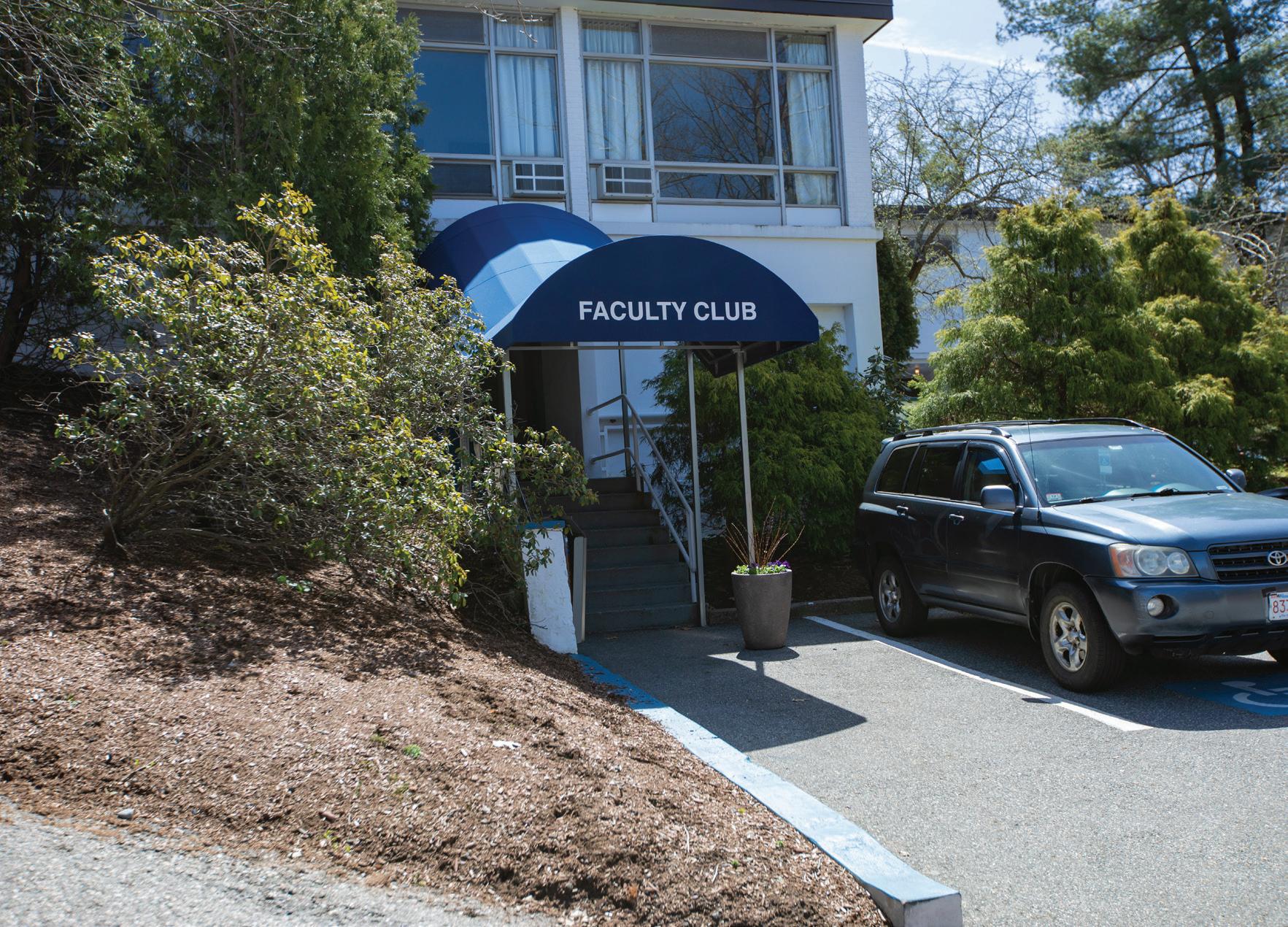
■ Members of the Brandeis community expressed their concerns and frustrations on a variety of subjects.
By LIN LIN HUTCHINSON AND SOPHIA DE LISI JUSTICE EDITOR AND JUSTICE ASSOCIATE EDITOROn April 9 at approximately 12:15 p.m., a group of members from facilities, students and assorted staff entered the Wien Faculty Center through its back entrance to present a petition communicating their discontent with administration’s recent decision to The Board of Trustees.
This demonstration comes in the wake of the University administration announcing that it intends to delay its “annual staff performance review and merit increases and faculty merit increases until the fall” in a March 14 email from President Ronald Liebowitz, Provost Carol Fierke and Vice President for Finance and Administration Stewart Uretsky. The email provided the community with an overview of the University’s financial situation as it faces “short and longterm financial shortfall” and is looking to make budget cuts to save money.
“The administration continuously sends insensitive emails that have a lot of, let’s say, difficult to digest information without much context or sympathy or empathy,” said a non-union staff member at the Heller School for Social Policy and Management in an interview with The Justice shortly after the gathering dispersed. Out of concern for their job security, this individual has requested to be anonymous. The announcement to put a hold on merit increases was announced to all staff — union and non-union — at the same time as the rest of the community.
Illustrating the impact of the decision on staff, a member of the Division of Science said, “Many of us are just kind of barely hanging on,” adding that the freezing of raises could potentially impact the experiences of students alongside staff and faculty. They further spoke on the indirect effects saying, “You’ve got to worry about people leaving … when the people leave departments … it can have knock-on effects that really mess with the functioning of different programs.”

In response to the sudden announcement, Brandeis staff worked in collaboration with Service Employees International Union Local 888 to develop a petition “calling on Brandeis administration to reverse its decision and keep our evaluations and raises on track for July.” As of the morning of April 15, the petition received over 300 signatures of undergraduate students, graduate student workers, staff, facilities employees, alumni and other community members. Following personal statements that were given at the Faculty Club during the gathering, several demonstrators attempted to deliver the petition to the Board of Trustees meeting next door.
The initial entry was difficult as the demonstrators were reportedly stopped from entering because “a gentleman in plain clothes started blocking the door and pulling it closed,” according to the previously mentioned Heller staff member. They said that this gentleman identified himself as the “head of the Brandeis police,” though The Justice was unable to confirm this claim as of press time.
“So I pushed the door open, and once I did that, he grabbed my arm and he shoved me over some of the glasses that were in the room,” they said, adding that the man did not immediately let go of their arm. Instead, another person present had to tell the man that he was pushing the individual into the glass in order for him to let go. They continued, “I am a staff person here, and I experienced violence while trying to exercise my freedom of speech and … defend the confiscation of my well-earned raise.”
Another faculty member at the University sent The Justice a video of the demonstrators entering the Board of Trustees meeting, but a board member told them to leave.
“Can you just go on the record as rejecting us, not wanting to speak with us right now? You just want to remain anonymous and tell us to leave?” a demonstrator behind the camera asked.
“I’m not going on any record at all,” the board member replied. They spoke over the demonstrators’ overlapping requests for comment, repeatedly asking them to leave while gesturing to the exit. The video caught President Ronald Liebowitz; the Chair of the Board of Trustees, Lisa Kranc ’75; and the rest of the board observing the interaction, but not interfering.
“So I worked at Brandeis [for] a few years and I care very deeply about this place,” a staff member of the Division of
In a faculty meeting that took place on April 12, President Ronald Liebowitz provided a statement following the recent Board of Trustees meeting regarding the current and future financial state of the University.
Brandeis has had seven straight years of a balanced budget. In other words, its revenues have either exceeded or balanced with its expenses, resulting in either an increase in money or a net zero balance.
The budget that was approved by the Board of Trustees as of last April showed that there should be a three million dollar surplus, meaning that the University should have brought in more revenue than the amount of money spent. However, the incomplete fiscal year of 2024 has a projected deficit of two million dollars.
Liebowitz explained that this five million dollar turnaround is a result of the lack of revenue from graduate student tuition. He went on to describe the projections for the 2025 fiscal year that also point to an operating deficit. Ac-
cording to Liebowitz, the projected revenue for masters programs is 17 million dollars lower than it had been prior to the Covid-19 pandemic. These numbers result in a total budget of 400 million dollars with the discretionary of the budget totaling to 225 million. According to Liebowitz, “that is a big mountain to climb.” He explained that the projected revenue was up, but not enough to be able to cover the decline in tuition from graduate students. Liebowitz stated “we have plans to address this issue, but a turnaround takes more than a year and so next year looks very tight.” He also expressed that an official report of the Board of Trustees meeting will be released, but was not available to The Justice by press time.
— Anna Martin6—A reporting party expressed concern that a party had passed out. BEMCo was dispatched, and the party refused medical care.
Apr. 6—A party reported hitting their head while intoxicated the previous night. The party refused medical treatment.
Apr. 7—A party experiencing chest pain and requested evaluation. Patient refused medical treatment.
Apr. 8—An ambulance was requested for a party who was feeling dizzy. Patient was transported for further medical care.
Apr. 11—A party complaining of chest pain had a medical emergency. Patient was transported to a local hospital.
Apr. 11—An unconscious party had a medical emergency. Patient was transported to a local hospital.
Apr. 11—A party was voluntarily hospitalized for psychiatric evaluation.
ACCIDENT/NO PERSONAL INJURY
Apr. 5—Reporting party reported that her car was hit while parked in the Athletics Lot. An investigation is to follow.
Apr. 6—A motor vehicle accident involved two cars, one car was towed.
In an April 11 Instagram post, Brandeis University announced their pride in being named one of two universities “nationwide to receive an A grade on the @adl_national’s Campus Antisemitism Report Card,” with Elon University being the only other school to receive an A. The Anti Defamation League’s campus antisemitism report card is meant to be used as a tool to measure the amount of antisemitism on university and college campuses, as well as how the respective schools respond to antisemitism.
In the Instagram post, the University also commented on the beliefs of Brandeis’ founders, expressing the “founders knew that hate often begins with but rarely ends at antisemitism” and reaffirmed their previous convictions to continue supporting “Jewish students, faculty, and staff” during times “when some campuses are struggling to protect those members of their communities.”
Apr. 10—A hit-and-run on a parked vehicle occurred between 8:00 a.m. and 12:20 p.m. An investigation is to follow.
■ An Arts and Culture teaser mispelled an author’s name as “Ester Balaban.” It was corrected to “Esther Balaban.” (April 9, Page 1)
■ An Arts and Culture article incorrectly mispelled a musician’s name as “Malman” and “Maloman.” It was corrected to “Malmon.” (March 5, Page 19).
■ Three photos were incorrectly attributed to Xilei Ceci Chen. They were corrected to photo courtesy of BRANDEIS DEPARTMENT OF STUDENT ENGAGEMENT (April 9, Page 2)
■ A News article incorrectly stated “Shoulson that said.” It was corrected to Shoulson said.” (April 2, Page 5)
■ A News brief misspelled a word as “mmembers”. It was corrected to “members”. (April 9, Page 3)
■ A News brief incorrectly stated “Wednesday, April 11.” It was corrected to “Thursday, April 11.” (April 9, Page 3).
■ A News article incorrectly repeated “The statements were read with emotion and the room was filled with fellow student-athletes, Haynie, coaches and other athletic administrators. The second occurance was removed. (April 9, Page 7)
■A
This recognition was mentioned during an April 12 faculty meeting where President Ronald Liebowitz expressed that “it was nice to get that recognition” for being “one of two schools out of 85 in the country that received those grades” to get an A.
— Eliza BierMISCELLANEOUS
Apr. 5—A reporting party reported an unknown male who entered the building and was in the bathroom. Male was a student and was sent on his way.
Apr. 6— Report of vandalism in the Goldfarb library. Situation was cleared.
Apr. 7—Party reported harassment via a dating app. An investigation is to follow.
Apr. 8—Reporting party reported that themself and a roommate had been woken up by “screaming and thumping” from the other room. Situation was cleared.
Apr. 8—A party reported that their laptop had been stolen. Situation was cleared.
Apr. 8—A party was smoking in their residence. Investigation to follow.
Apr. 9—A disturbance occurred at the Trustee/s meeting. An investigation is to follow.
Apr. 10—A party in the lobby reported that their stolen property had been tracked to the Mandel Center for the Humanities and requested assistance. The service was rendered.
— Compiled by Zoe Zachary

■ Panelists discuss the potential social media has in amplifying voices of marginalized groups and giving space for the youth to advocate for worldwide social change.
By IANNA GILBERT JUSTICE CONTRIBUTING WRITERThe fourth Dialogue and Action in the Age of Divides panel discussion was held on April 2, with the intention of discussing social media’s role in influencing modern discourse. Moderated by Deb K. Roy, the Professor of Media Arts and Sciences and Director of Center for Constructive Communication at the Massachusetts Institute of Technology, sets the foundation of the conversation by denoting ‘constructive dialogue.’ “Those forms of communication … foster an authentic and accurate understanding of others,” Roy said. “We can contrast that with the various forms of communication that might amplify, inaccurate and overly simplify stereotypes of others.” After listing statistics related to the political divides in the country and clarifying the value of constructive dialogue with regards to strengthening communities and institutions, the panelists began to chime in.
To preface the conversation, Brooke Foucault Welles, the Associate Dean of Research and Professor of Communication Studies at Northeastern University, clarified the difference between dialogue and discourse. She defined ‘dialogue’ as “a two-way cooperative conversation designed to build understanding within the kind of context of relationships” and described ‘discourse’ as something that “potentially designed to build understanding, but is generally understood to be more one way … so it’s the kind of broadcasting or spreading of information without necessarily the expectation of the reciprocity or the conversation between.”
To connect these definitions to the topic of social media, Welles makes the assertion that social media is fairly one-sided and that it involves much more discourse than discussion. As Welles noted, from a computational social science point of view, it seems that there may be fewer discussions taking place, but she also recognizes that much of the dialogue takes place offline
or in private spaces. She introduced the idea that with social media, “there is a kind of amplification effect or an algorithm effect around sensational topics which can be both good or bad.” While explaining, Welles mentions that these sensational stories can be misleading, but at the same time, the algorithm effect can help to bring awareness to certain events such as with Michael Brown’s murder in Ferguson Missouri.
Nick Seaver, the Assistant Professor of Anthropology and Director of Science, Technology and Society Program at Tufts University, added his perspective on the algorithm effect with regards to sensational topics. He warned that one should be “wary of pointing to the algorithm as the reason for that there is sensational efforts to grasp at things sensationally.” He further clarifies that the intention is not to claim stories that include elements of pathos are suspect because of their subject matter; rather, individuals who have intense feelings about certain topics should be included in conversations and granted the opportunity to voice their thoughts, allowing them to be amplified and heard. According to Seaver, the algorithm effect shouldn’t be blamed for the amplification effect but rather conversations should be around how we can include and hear from more people of marginalized groups.
One of the panelists, Jonathan Corpus Ong, The Associate Professor of Global Digital Media and Director of the Global Technology for Social Justice Lab at University of Massachusetts Amherst contributed their perspective regarding having safe spaces for minority groups. He stated that “it is important to hold those safe spaces because there is a sense of trust that people have your back and the people who have curated such a safe space know the background of the participants, know where they are coming from, and the risk that they are taking of being present there.”
Ong references the “South To South Knowledge Exchange Series” where activists, journalists, researchers and experts come together with the purpose of “centering global south experiences and identities to innovate” and to get rid of the idea of social media brainwashing. This series is introduced as an example of constructive dialogue being effective but Ong also explains the contrary, elaborating on the risks marginalized groups take to be in those spaces since they can be exhausting. “For such events we are called in and expected to show up and represent our community,” Ong said. “It often seems like people are curious about us for our suffering and our trauma that we are asked to narrate.”
■ Brandeis police diffused the situation and asked all involved parties to leave the premises.
By ANIKA JAIN JUSTICE ASSOCIATE EDITOROn April 14 at approximately 4:27 p.m., multiple students were involved in a physical altercation on Chapel’s Field during Springfest, the University’s annual spring concert. Video footage shared with The Justice on April 15 shows that the students were fighting over an Israeli flag.
Students first reported seeing people taking photos with the flag during Modsfest, a widely attended pre-concert gathering, throughout Foster Mods. At Springfest, a student first brandished the flag during Isabella Lovestory’s set. In response, multiple audience members began arguing with the individual, asking them to put the flag down. Noticing the tension in the audience, Lovestory asked students to get along with each other and have a good time at the concert. The individual put the flag down in response to Lovestory’s request but soon waved it again. Another student attempted to seize the flag from the individual’s hands at around 4:27 p.m. Neither one let go of the flag, resulting in a physical altercation. While the exact number of students involved is unclear at this time, video footage shows multiple students being pushed as a result of the fight and multiple concerned onlookers shouting. Spectators also reported that Lovestory said “Free Palestine” as she walked off the stage. At 4:37 p.m., a police officer approached the individual with the flag. The dialogue is undecipherable from the video, but the individual soon raised the flag again. A different student came up behind them, snatched the flag and ran
away from the stage. The flag owner chased after them. The student from the initial altercation and another student followed closely behind.
The flag owner grabbed the person who stole the flag. The student from the initial altercation went to their aid, and all three fell to the ground. All four students involved in the chase attempted to pull the flag. As police approached the situation, one student backed away. An officer grabbed the student who snatched the flag the second time and asked them to leave while the student from the initial altercation and the flag owner continued to fight over the flag.
The same officer then told the remaining two students to disperse. Four other officers provided backup, spoke with the involved parties and escorted them off of Chapel’s Field. As of press time, no formal charges have been made against any of the students involved in the altercation. Brandeis Chief of Police Matthew Rushton did not respond to The Justice’s request for comment.
Multiple users on Sidechat debated the situation. While some argued that people often bring flags of where they’re from to wave at concerts as a symbol of national pride, others argued that the flag had no place at Springfest.
One user wrote in disapproval of the flag display, “As someone who supports israel i agree like this is a school concert and none of the artists are israeli???”
Another commented, “Remember when terrorists ruined an innocent dance festival on October 7? Let us dance for our people.”
Since Oct. 7, 2023, tensions have been high on Brandeis’ campus regarding the war in Gaza.
Last November, the University derecognized the University chapter of Students for Justice in Palestine, sparking a protest that culminated in the arrests of seven individuals.
— Editor’s Note: Staff Writer River Simard ’26 contributed to the reporting of this article.

Conversations in these safe spaces are less about seeking out solutions, causing individuals to feel as though they are “case studies for other people to think through.” This approach dehumanizes people, and to a certain extent, social media exhibits similar challenges by limiting the voices of marginalized groups. Ong stated, “what sells on social media are the topics that have the loudest voices and extreme positions rather than the new voices/positions.” The detrimental effect of social media is that it makes space for the amplification of extreme positions which in turn overshadows the perspectives and voices of marginalized groups.
Another challenge that is exhibited with social media is that young people are beginning to develop a fear of cancel culture, causing them to not want to “put themselves out there.” Linda Charmaraman, the Senior Research Scientist at Wellesley Centers for Women, explains that young people “are almost afraid to be who they are and open up that dialogue that might be difficult.” Charmaraman says that their comments can be taken out of context and because one’s digital footprint lasts forever, the young users are more inclined to stay quiet rather than risk their words being misconstrued. The discussion highlights the negative impacts of social media with regards to its effect on a person’s mental health.
In adding to the discussion, Welles acknowledges these impacts. She explains that “it is a real shame when we tell young people not to use social media for their mental health or because it is dangerous.” Dangerous, because it depoliticized the young people, according to Welles. Especially in recent years, Welles stated that “social movements in the U.S. and around the world have been motivated and led by young people … so I do worry that there is a complicating factor in there that we are not talking about the politics or the meaning of when we say push the young people out of these spaces.”’
The panelists left the audience with various takeaways. Welles encourages viewers to “think about dialogue beyond the personto-person or the dyad and think about dialogue as something that happens within and between groups, not all of whom show up every single time.” By encouraging constructive discussions rather than discourse, an inclusive environment can be created where social media positively impacts all members of society.
■ The Justice spoke to A-board co-chairs and club leaders regarding the Annual Marathon Report.By ANIKA JAIN JUSTICE ASSOCIATE EDITOR
On April 9, the Student Union Allocations Board shared the Annual Marathon Report with club leaders. Clubs on campus requested $3,324,464.56 of which $1,703,124.89 was allocated. On average, clubs received nearly 49 percent less funding than what they asked for.
These results are similar to the marathon report from 2023. Last year, clubs requested $2,912,000 of which $1,476,415 was allocated — placing club funding at approximately 49 percent of requested funding.
Club funding comes from the Student Activities Fee, which is supported by one percent of student tuition, as well as rollover funds not spent the prior fiscal year.
One club that received significantly less than what they requested is the Brandeis Asian American Students Association who requested $46,781.50 and received $18,063.50 — 62 percent less than what they need for events like their culture show Apahm. In an April 15 statement to The Justice, BAASA President Layla Hay ’25 and Vice President Kevin Cui ’26 wrote, “This year’s marathon results were disappointing to say the least, as we received less than half of what we requested. It is an unfortunate situation as we are one of the few groups representing Asian American Pacific Island students on campus, and despite facing a massive budget cut the previous year, we are having to deal with another halving of our budget.”
According to A-Board Co-Chair Rashail Waisim ’25, the board set aside a new pool of funds to cover event charges related to Facilities, Media Technology Services, Public Safety and BEMCo. “Previously all clubs had to pay for these costs from their own budgets, and now A-Board is paying those costs directly,” he wrote in an April 15 statement to The Justice. “We introduced this change to make budgeting easier for clubs, and next year will be the first full year the change is in effect.”
Clubs under the Intercultural Center asked for $451,274.29 altogether and received $224,282.30 — approximately half of the amount they requested. “The cultural clubs at Brandeis play a super important role in student life and promoting Brandeis’ mission of diversity and inclusion. And so the administration and Student Union should make an effort to ensure our clubs can actually function and have resources for events,” Hay and Cui wrote.
“We understand the limited funding that A-Board has in supporting and funding all the different student organizations on campus,” said the executive board of the Taiwan Student Association in an April 15 statement to The Justice. “However, it is a little frustrating … when the A-Board doesn’t
fully understand how the ICC and cultural clubs or our events function.” The TSA requested $25,123.36 and received $15,426.73.
According to the TSA, the A-Board considered their event Night Market, which “celebrates various cultures at Brandeis with a fusion of Taiwanese culture,” to be a culture show. Consequently, the funds that they typically receive for their annual cultural show have now been split between Night Market and their actual cultural show, Formosa. They referred to the classification as “a little startling and shocking.”
“Due to limited funding, we now have to consider canceling Night Market in order to fully dedicate our funds towards having a successful Formosa, which would be unfair to our culture and our club’s traditions, as well as to students who look forward to both events every year,” the TSA told The Justice.
According to Waisim, “Most clubs, not just cultural clubs, saw a decrease in their annual budgets, because they are no longer required to pay for the overhead costs of large, on-campus events, such as culture shows, out of their own budget.” However, ICC clubs still find that the allocated funds fall short for key parts of the budget for their culture shows. “South Asian Student Association... requested $58,270 of which $20,170 was approved. Despite being warned about budget cuts, we were pretty shocked and panicked to see this, as it was lower than our semester budgets in previous years,” SASA Co-President Srishti Kaushik ’26 told The Justice on April 15.
The budget for SASA’s annual cultural show MELA was cut in half, from the $24,700 requested to the $12,000 allocated. “MELA is the biggest cultural show on campus, as well as the biggest student-run production. Hundreds of students from the South Asian community and beyond are involved in volunteering, performing, and organizing the event. In terms of participation and involvement, MELA has only been expanding in recent years, and our E-board is already scrambling to figure out how to prepare for this reduced budget,” said Kaushik.
She explained that for months leading up to the show, SASA members paint a full canvas backdrop. However, A-board did not approve any money to be spent on Paint Nights, which are events where all members of the community are invited to help paint the backdrop. SASA requested $650 in the first round of Marathon to be directed toward Paint Nights and again during appeals.
“While we have faith in ourselves as an E-board, we know it’s going to be difficult next semester figuring out how to run on this significantly reduced budget,” Kaushik said.
“The school is quick to post our events on social media to showcase their ‘diversity’ yet continue to significantly cut our funding. It feels quite performative and it makes members of these culture clubs (who are majority POC) feel neglected.” Hay and Cui highlighted the irony of ICC clubs and culture shows receiving less funding.

■ What originally started off as a project for an environmental science course has evolved into a fully-fledged plan for on-campus afforestaton.
By ZOE ZACHARY JUSTICE EDITORMicroforests are becoming an increasingly popular method to introduce native greenery into urban spaces. Brandeis Microforest members Audrey de Garmo ’26, Arryn Clanaugh ’26, Katy Tanzer ’25, Maya Haubrich ’24 and Lily McCarthy ’25 aim to make this project a reality.
In an April 11 interview with The Justice, De Garmo, Clanaugh and Tanzer discussed their microforest project on the Brandeis campus. De Garmo explained what a microforest is: “A microforest is essentially a really densely planted forest. It’s made of native species,” she said. “It’s not like traditional afforestation methods where people tend to plant one species and [they’re] spaced evenly and in straight lines … everything is super densely planted, and the point of that is to mimic the environment of a natural forest.” Brandeis Microforest plans on using the Miyawaki method in planting their microforest, which focuses on using natural reforestation principles to quickly grow a forest on degraded land that has been used for agriculture or construction. According to de Garmo, this method is up to ten times faster than a typical afforestation project. Microforests are unique in that they contain solely species native to their area. “A natural native forest would have canopy trees, then trees, then sub trees and then shrubs and ground species,” de Garmo explained. “The idea is to mimic that. We’re planting a bunch of canopy species, red spruce, eastern red cedar, sweet birch, white oak, eastern white pine, those are going to be some of our taller species. And then we have some shrubs, sumac, chokeberry, elderberry, raspberry, hazelnut, stuff like that.” In total, Brandeis Microforest plans on planting over 30 different species, which includes a variety of trees, weeds and flowers. Since microforests are composed of native species and mature quickly, Brandeis Microforest
anticipates only having to maintain the forest for two or three years before it can sustain itself.
The idea to build a microforest on campus originated as a class project. According to de Garmo, the original idea was to build a pollinator garden similar to the one outside of the Carl J. Shapiro Science Center. De Garmo explained that it was Prof. Colleen Hitchcock (BIOL) who suggested they build a microforest.
Clanaugh clarified that Brandeis Microforest has funding from the Brandeis Sustainability Fund to create the forest, and that they plan on planting on May 4 and 5. The microforest will be planted in between South Street and the Slosberg Music Center, and will have an area of around 35 square meters. Additionally, all of the plants for the microforest will be sourced from local nurseries.
Tanzer discussed some of the benefits of having a microforest on campus. “[The microforest] is a good chance to get everybody involved, not just environmental science students … it’ll be nice having something on campus where people can go and connect to [nature].” In de Garmo’s words, “We’re a little isolated here. A lot of people don’t have cars, you can’t necessarily drive somewhere to have access to nature. So I’m really excited about the fact that we’re going to have a little forest on campus.”
The benefits of a microforest aren’t limited to student mental health and building community. According to an infographic on Brandeis Microforest’s Instagram, “Microforests sequester carbon, decrease erosion and flooding, lower temperatures in urban areas, and foster biodiversity by creating habitats for insects, birds, and other wildlife.” An article by Earth. org goes into further detail of how microforests are a useful tool in slowing down climate change due to their ability to store atmospheric carbon.
Though the goal is for the microforest to be self-sustaining, the project is in a stage that requires a lot of hands-on work. “We’re looking for people to help us plant the trees,” Clanaugh expressed. “We’re definitely going to make a big event out of it.” For those who would like further information about the microforest and getting involved, Brandeis Microforest encourages students to follow their Instagram under the username @brandeismicroforest.

‘Hero Camp!’: how Live Action Roleplay helped three teens find themselves
■ The documentary, produced by Sam Ho ’20, centered around The Story School, a summer camp featuring live action role-play.
By ZOE ZACHARY JUSTICE EDITOROn April 14, director Sam Ho ’20, visited the University to screen his documentary, “Hero Camp!”. The screening took place in Mandel Center for the Humanities, and was followed by a brief Q&A with a couple of the documentary’s primary subjects and part of the production team alongside Ho. The event was part of the 2024 Leonard Bernstein Festival of the Creative Arts.
The event started with a brief introduction from the Director of Arts Engament and Communications, Ingrid Schorr, who oversees the Leonard Bernstein Festival of the Arts. She noted that “Hero Camp!” has received a thumbs-up from the entire Festival of the Arts committee, and briefly explained some of the goals of the festival. Ho also explained that this screening of “Hero Camp!” is a work-in-progress screening and that the audience would be invited to give feedback after the event.
“Hero Camp!” takes place at The Story School, an overnight camp located in Charlton, Massachusetts. At The Story School, campers are immersed in live action role-play. Unlike traditional overnight camps, The Story School provides its campers with the opportunity to live out an intricately-designed story in the fantasy world of Sidleterra. Campers and counselors alike role-play as heroes, villains, monsters and more.
What sets LARP apart from most styles of gameplay is that each participant is essentially acting as a character in real time. Gameplay includes dressing in costume and acting out fight scenes and storyline interactions, all completely in-character. Though LARP is most often used in the context of fantasy storylines, its definition is expansive. For example, events such as Civil War reenactments can be classified as LARP. An article from VICE details LARP’s recent rise in popularity, starting in the 1970s with the popularization of fantasy role-playing games such as Dungeons and Dragons.
A large portion of campers at The Story School identify as LGBTQ+ or neurodivergent. “Hero Camp!” focuses in on these identities, following three LGBTQ+ campers who had discovered these aspects of their identities at The Story School. Through Ho’s storytelling, Ryan (she/her), Soul (he/they) and Anakin (he/him), were able to articulate how The Story School had helped them discover and grow into their identities. In Soul’s words, attending The Story School comes along with a sense of “pure confidence of being able to exist in an environment where all the people are just as weird as you are … it’s empowering to know
these people exist too.”
After the screening of “Hero Camp!”, which has a runtime of one hour and seventeen minutes, documentarian Jenny Alexander moderated a Q&A panel with several people involved in the documentary’s making. The panel included Ho, producer Claire Ogden ’21, producer Alissa Fagin ’20, cinematographer Colin Hodgson ’20 and Ryan and Soul, two campers who were featured in the documentary.
One theme that the team frequently touched upon was the all-encapsulating environment of acceptance that The Story School is able to create for its campers which allowed for self-discovery. Much of this acceptance is attributed to the inherent nature of LARPing, which allows campers to explore their identities through the fictional character that they designed and role-played. Ryan, on the nature of LARP, commended that there is a “general atmosphere of receptiveness that everyone there is supposed to have.” This kind of receptiveness makes LARP an especially friendly environment for members of the LBGTQ+ community. “Most of the trans people I know, I know from this camp,” Ryan commented.
The creators of the documentary were able to comment on LARP from an outside perspective. Fagin had no previous experience with LARP and she commented on how it made her emotional to see how “people could be so inhibited … places like [The Story School] are so special.” For her, one of the most emotional and revealing moments in producing “Hero Camp!” was watching one of the campers “falling into the grass when he won a battle.” In Ogden’s words, “it’s a camp where these ‘weird gay kids,’ I say that lovingly, discover their identities.”
Ryan and Soul described the profound impacts of having such a niche community as the one at The Story School. “It feels good to know that not only do people get to know about this experience, but I am not the only one who has gone through this kind of thing. I am not the only one who has my problems,” Soul commented. Ryan, who worked as a counselor for the camp, added “It’s surreal … You’re seeing your own story play out with other people.”
Ho was inspired to make “Hero Camp!” during his work as a videographer for The Story School. According to Ho, he wasn’t expecting to make a documentary that summer — he had been planning on working at Home Depot when a friend recommended he apply to The Story School. Ho, who majored in Film, Television, and Interactive Media at Brandeis, quickly saw the significance of the campers’ experiences and decided he wanted to tell their stories. “I wanted this film to be a representation of that experience of growing up and finding who you are,” he commented.
Ryan and Soul both testified to how Ho had become part of the camp’s community, and that the campers “absolutely loved Sam.” In their words, “He kept the safe haven safe … and that safety extended to [the making of the documentary].” To watch “Hero Camp! and follow its journey, resources are available at samhocreative.com/herocamp.

■ The event centered around financial inequality and power dynamics pertaining to the societal impact of prisons.
By JULIA HARDY JUSTICE ASSOCIATE EDITOROn April 11, the Brandeis Equal Justice Initiative organized a movie screening of “The Prison in Twelve Landscapes,” followed by a discussion with two panelists in Golding Judaica. The programming was facilitated by BEJI co-directors Prof. Rosalind Kabrhel (LGLS) and Prof. David Sherman (ENG).
The event centered around social justice related to the prison system, as well as general education on the realities of the carceral system. BEJI was established in 2019 and aims to open “educational pathways for those impacted by the criminal justice system and advances carceral studies at Brandeis.”
In keeping with BEJI’s desire to educate on the criminal justice system, Sherman shared a slideshow of images from prisonmap.com, illustrating bird’s-eye views of various prisons across the United States before officially starting the event. Sherman described these images and then posed the question, “where is the carceral system?” After various contributions to this question, the room reached the conclusion that the prison system is everywhere in society.
After this informal introduction to the event, Sherman began discussing the film. “The Prison in Twelve Landscapes,” produced and directed by Brett Story, is a documentary released in 2016 that explores how the carceral system in the U.S. impacts entire communities, even beyond the physical prison facilities. The movie follows different narratives and perspectives that all come together to make up the greater picture of how the carceral system affects every aspect of life.
Sherman described the documentary as an “interesting documentary in its form . . . it’s fragmented.” Without much further introduction beyond informing the audience about the lack of one storyline or narrative, he started the film.
The film ran approximately one hour and 30 minutes, and afterwards there was a 10 minute intermission before starting the discussion.
After reconvening, Sherman introduced the two panelists. In discussion was Angela “Angie” Jefferson, a motivational speaker who uses her experience with the prison system to raise awareness of its injustices. She has worked with the National Council for Incarcerated and Formerly Incarcerated Women and Girls, as well as being a part of the Partakers Empowerment Program.
Joining Jefferson was Dawud Abdul Basir, who is also in -
volved in the Partakers Empowerment Program. Abdul Basir shared that he spent 44 years in prison, which informed many of his contributions to the discussion.
Sherman began the discussion by asking for basic observations, takeaways and scenes that stood out to people. From this question, participants in the event pulled on three main themes from the movie: power, money and justice.
Jefferson started the conversation surrounding money by referencing a scene in the movie that depicted families of incarcerated individuals waiting in line to see their loved ones. These families were required to pay fees, including approximately seven dollars for every call they made to their loved ones, which doesn’t include the money they had to spend to visit to see their incarcerated families. A woman in the film said: “‘So they’re making a killer off of people who have loved ones incarcerated.”’
As someone who served 31 years in the Massachusetts Correctional Institution-Framingham, Jefferson pulled on her own experiences to react to the reference of calling fees. She talked about her time in prison and how “everything in that prison was money,” and that the incarcerated “put a lot of money into this [carceral] system.” She drew strong parallels between the movie and her life, by telling the audience that to call her children, she would keep the money to pay for the fees on her phone. She used to call her children everyday and “100 dollars stayed on [her]” at all times, because it was cheaper for her to pay it than to have her children, due to high fees.
Furthering the conversation, Abdul Basir led the discussion in the direction of power dynamics. He said that he has seen “The Prison in Twelve Landscapes” a few times and that he always thinks about how power hierarchies operate in the prison system. He said, “The first thing that came to mind was [the] United Nations.” He went on to elaborate on this statement by adding, “To me, that movie is all about power.” Abdul Basir talked about how the “power dynamics” in society places some at the top with all the power and others far below with no power. He said that the UN is an example of this, because a small number of countries control all the others. The prison system offers an example of this power imbalance, because the incarcerated are on the bottom rung in society, while those at the top are making money at the inmates’ expense.
In response to these power dynamics, Abdul Basir expressed that we need equality, but he specifically defined equality when he said, “This world will not be just . . . until equality comes down to A equals B.” He emphasized that people can disagree, but they need to respect one another in order to create a just and equal society.
Transitioning to Sherman’s request of scenes that stood out to the viewers, many participants commented on the documentary’s reference to female prisoners who were enlisted
as firefighters to contain wildfires in California, highlighting themes of money and the injustice of the prison system
In an interview with The Justice before the start of the discussion, Tasha Epstein ’25 referred to the constrictions of incarcerated firefighters by saying “that’s such bullshit,” and later commented in the discussion how they were most likely not paid for their work and couldn’t utilize their skills outside of the prison system. Jefferson responded by saying, ”They probably didn’t [pay them] . . . 9 times out of 10.”
Many of the students in attendance had been exposed to the carceral system, including Epstein and Ella Subramanian ’24. Despite their previous exposure to the topic, they both expressed shock at the injustices and dehumanization displayed in the film. In the same interview after the film, Epstein explained, “The system is supposed to work to . . . rehabilitate people,” but “it’s not even fair in the way it’s supposed to work.” Subramanian said, “there are so many things that are shocking about it [the system as portrayed in the movie],” in an interview with The Justice immediately after the post-film discussion.
This expression of shock was also seen when the conversation turned to a story told in the film about a woman who was fined 175 dollars for not having secured a trash can lid properly. As the woman was sharing her story, she began to tear up at the injustices she faced regarding the ticket, as well as her time in jail. Kabrhel said, “She told that story . . . in such a poignant way,” and expressed how stories like hers put humanity into the social activist work. Subramanian succinctly put it, ”it’s crazy she got arrested.”
In response to the scene, Sherman said that no one knows where to start with dismantling the oppressive system, because “it’s the system too big to fail.” However, in an interview after the discussion, Jefferson said, “we still have a long way to go,” but “I really believe there’s power in numbers.”
Abdul Basir further expressed that “you have to start taking an interest,” meaning people must become educated on the realities of the carceral system. In an interview with The Justice, he directly referred to students when he said, “It’s time for the students to ask the question: ‘Where’s my money going and why am I still getting a bad product?’”
A large part of BEJI’s initiative is education based, which was achieved through the film as well as the discussion afterwards. While the end of the discussion didn’t lead to any concrete further steps, the event provided participants a lot to think about regarding the current state of the incarceration system in the U.S.

CONTINUED FROM 1
Sciences at the University shared in an April 15 interview with The Justice. They are involved with this undertaking to “advocate for [themselves] and to advocate for people who are in departments that are so understaffed and overworked that they themselves can’t be involved just because they don’t have time.” They said they have friends within the University staff that “do the job of multiple people” despite not receiving compensation they feel is adequate.
“Brandeis is undergoing a moment of identity shift where they have a lot of decisions that they’re making about free speech and expression, and the valuing of underserved and underprivileged communities here on campus,” the Heller School employee told The Justice. “It seems like every step they’re taking is in the wrong direction. And I think they took another misstep today,” they said in reference to the University’s response to the demonstration.
Continuing their efforts, a rally is scheduled to be held on April 16 at 11:30 a.m., which will include “custodians, tradespeople, groundskeepers, librarians, graduate students, and representatives from SEIU Local 509, SEIU Local 888, 32BJ SEIU, and allies.” The rally is anticipated to gather at the Bernstein-Marcus Administration Center. The different unions that represent the University’s staff will gather “to demonstrate their unity as each union enters into negotiations on contracts that will expire on Sunday, June 30, 2024,” an April 15 press release sent to The Justice said. The press release added that many of these demonstrators were faculty members that “risked their health” by working through COVID-19 “only to suffer the post-pandemic shock of runaway inflation and exploding housing costs.” The rally will consist of workers who will share their stories and show their support for one another as they enter negotiation.
CONTINUED FROM 1
on the Brandeis campus.
Following this section, the report describes an email that was sent to the Brandeis community on the morning of Nov. 10 co-authored by Dine and Rushton. This email identified phrases that would be seen as threats and emphasized that participants from outside the Brandeis community were not allowed on campus. The email also explained that security measures had been increased. Additionally, they attached a link to the University protest policy, available on the Brandeis University website. The email concluded with the statement, “we anticipate that our community will respect the rights of others while exercising their own rights.”
In advance of the protest, the university administration made arrangements for the Waltham Police Department to be present alongside BUPD. The report also detailed the presence of “contract security personnel (i.e., non-sworn security).” These professionals were present to “assist with checking participants’ identifications to confirm that the participants were University affiliates.” The increased security was said to be a response to “the potential size of the demonstration, the likely presence of non-affiliates (including potential opportunists seeking to agitate or provoke events that draw media or social media attention), and the potential need for multi-jurisdictional resources.”
According to the report, “despite a growing administration concern about potential escalation in the event outside parties joined the Protest on campus, the Brandeis administration planned to take a largely passive role in observing the protest.” However, the report listed out reasons why they assumed this protest would be different than others previous including “the University had declared that specific statements likely to be made at the Protest constituted threatening or harassing speech,” “the University had credible information indicating the presence of outsiders, not only in response to the underlying Israel-Hamas Conflict, but also in response to the derecognition of the Brandeis SJP,” and “campuses across the country were seeing an increase in the number of protests resulting in physical hostility between demonstrators, counter-demonstrators, and others.”
The analysis section of the report was summarized with the statement: “This Review answers two questions: (1) whether Student Affairs’ actions in its response to the Protest, including its determination that the Protest should be dispersed were consistent with the University’s stated rules concerning protests; and (2) whether the BUPD’s actions in dispersing the Protest were consistent with University policies and industry best practices, and where force was used, whether it was necessary and
appropriate under the circumstances.” A part of this analysis section detailed that there had been confusion surrounding topics such as why police were present as displayed in the community listening session. It went on to further develop why administration and law enforcement were in the right, justifying actions taken against Brandeis community members and non-affiliated event attendees and the results that followed.
The report concluded with a list of recommendations for the University based on the evidence observed during the investigation. This list included is as follows:
“The University should consider requiring more direct communication with protest organizers in advance of a protest.”
“The University should direct communications regarding protest concerns in a more timely and widespread manner.”
“The University should consider assigning an administrator who is not the Vice President of Student Affairs to assist with protests.”
“The BUPD should not co-author messages articulating speech policy to avoid creating the impression that the contours of free speech are established by law enforcement.”
“The University should communicate with the community regarding the rationale underlying police presence on campus, specifically with respect to demonstrations.”
“The BUPD should work to better leverage its website and social media in the effort to build its police-community bond.”
“The University should explore methods to enhance its ability to screen for nonaffiliates at future protests.”
“The University should consider posting signage advising non-affiliates that their presence on campus will be deemed trespassing.”
“The University should ensure that all BUPD officers receive biennial crowd control response training.”
“The University should consider discontinuing use of contract security to assist in crowd dispersal.”
“The University should consider adopting procedural guidelines for responses to campus disturbances that reflect operations during the Protest.”
“The University should provide coordinated interdepartmental training on responding to incidents occurring during a campus protest.”
The Revolutionary Students Organization has collaborated with SJP in the past and has supported them as they have been de-chartered. They have also held protests in support of Palestine since Nov. 10. When asked about how the report has affected the students in their organization and how they planned on moving
forward in an April 13 correspondence with The Justice, they stated “The report only serves to remind us of the university administration's willingness to lie, as well as its lack of regard for both the truth and the safety of its students. We plan to continue and deepen our efforts on campus to pressure the university to stop supporting the Zionist occupation and the genocide it is committing against Palestinian people.”
This concept of misinformation was a common theme when speaking with Brandeis community members. However, misinformation can mean many things. Prof. Jonathan Sarna (NEJS) explained that he is in support of the report. In an April 11 exchange with The Justice, Sarna stated, “The report reveals how much misinformation circulated at the time that the incident occurred and was discussed by the faculty and in the media. Many faculty refused to believe that the demonstration was orchestrated by outside forces, and they denied that the police had been attacked. Now we know better. The faculty who spoke out in condemnation of law enforcement and the administration owe both a deep apology. Let's hope that lessons will be learned and that justice will be served.”
The community has also expressed concern regarding the choice of law firm that the University hired to complete the investigation.
In an April 12 exchange with Prof. Naghmeh Sohrabi (HIST), she told The Justice “Considering the financial straits we're in right now and the cost of hiring the law firm HIRSCH ROBERTS WEINSTEIN LLP (which specializes in, among other things, defending universities against Title IV accusations), it's hard not to wonder if the money wouldn't have been better spent on an investigation that was also interested in helping the University protect the rights of its primary stakeholders — its students — to express themselves without the looming threat of arrest by various police forces on their own campus.” At a faculty meeting on April 12, Liebowitz informed Brandeis faculty that the University is three million dollars in deficit, five million lower than the two million increase that was expected.
The specific content of the report was also questioned, as community members expressed concern regarding the specific focuses of the report. Sohrabi stated “It seems like a missed opportunity to not have had an investigation where the paid investigators interviewed more than just two people and were thus able to suggest alternatives to policing at a time when our student body is engaged with difficult real world issues on our wonderfully diverse campus.” In an April 13 exchange with The Justice, Prof. Laura Miller (SOC) stated “I was disappointed that so much of the Hirsch Roberts Weinstein
report focused on university communication and so-called optics rather than recognizing serious divisions on campus about substantive university policies regarding speech, protest events and police presence on campus … Relatedly, the report evaded the question of what actions could have been taken to de-escalate tensions on November 10th, and in the future, when students do not comply with contested university policies. The last thing I would want to see is the normalization of arrests as a means to deal with demonstrations, whether ‘unruly’ or not.” Some felt that the report provided a simplification of events and perspectives that was problematic. This idea was confirmed by a statement made to The Justice by Prof. Bernadette Brooten (NEJS/WGS) on April 15. She stated, “In the face of what the International Court of Justice and a U.S. Federal court have deemed to be a plausible claim of genocide in Gaza, the Brandeis administration prohibits words that it claims call for “violence, death, or annihilation.” This narrow report simply accepts the administration’s claim, finding almost all subsequent actions to be justified. History will not look kindly on all who silenced opposition to the destruction of Gaza and its people.” The conclusion of the email sent on April 9 discusses how the university administration is moving forward following the release of the report. It states “the recently convened Presidential Task Force on Free Expression will be examining and making recommendations for changes or improvements to our current Principles of Free Speech and Free Expression, as well as the processes and protocols Brandeis uses to apply those Principles to our academic and co-curricular activities. This Task Force is expected to submit its recommendation no later than December 31, 2024.” While Brandeis has implemented many task forces in the past, this one has been supported by many community members. Miller states “The report did identify what I view as the crux of the problem, which is the process for determining restrictions on speech. However, this statement was buried in a footnote and the reviewers explicitly declined to weigh in on whether that process is currently fair or reasonable. My hope is that processes for determining the boundaries on acceptable speech at Brandeis, and how they are applied, will be more thoroughly reviewed by the newly formed Presidential Task Force on Free Expression.” While the investigation has concluded and the report has been released, the events of Nov. 10 are still garnering mixed reactions and current actions across campus.

On April 6, The Justice was able to sit in during the last Melody Mentors of the semester, where participants put the finishing touches to their semester-long projects and reflected on their experiences.By RIA ESCAMILLA-GIL JUSTICE STAFF WRITER
On a Saturday afternoon, 15 high school students were sitting inside of a Sound and Image Media Studios classroom. After enjoying some snacks, the groups split into several areas across the SIMS department rooms to finalize their projects from the semester. These projects are part of Melody Mentors, an initiative which began in the spring of 2023. Melody Mentors is an initiative which plans to run every spring semester as part of Basement Records, a student-run organization on campus dedicated to supporting student musicians, and with support from Samuels Ceneter for Community Partnerships and Civic Transformation. The program matches high school students throughout the Waltham area with Brandeis students to support them in their musical careers.
Liz Sandoval ’25, founder of Melody Mentors, is a current junior studying Business and Psychology with a minor in Creativity, the Arts, and Social Transformation. Sandoval shared that she came up with the idea when she was in the cohort of Samuel Scholars a year ago. “The mentorship piece was inspired because growing up, I was part of the church and I saw how a lot of the older kids would mentor the younger kids on how to use the instruments and other things. We saw that every Saturday, Africano Waltham already had enrichment days, something in relation to the arts and culture, creativity — and we pitched the idea to the founder of Africano Waltham and she liked it.”
For this spring semester, the program hosted 15 high school students
from Waltham and 11 mentors from the Brandeis undergraduate community who held an interest in mentoring younger students in the music world. The Justice got to speak with students from different high schools and grade levels who each had something to say about their experience with Melody Mentors. Elizabeth Robinson, a current sophomore at Waltham High School, shared that the experience was memorable, “Working with the members in my group, having the bonding experience, and getting to meet new people.” Her group with Zyana Mugabi, a freshman from Tewksbury Memorial High School and Hannah Nambooze, a sophomore from Medford High School worked on a song called, “The Idea of Love,” a rhythm and blues song inspired by similar music from the 90s. After listening to a few parts of the song, along with their mentor, the students decided on which section of the song would become the chorus and what transition to use for one of its segments.
Christian Momeremier, a junior at Woodburn Memorial High School, shared that the mentorship program helped him as someone with no previous experience with music. “It enlightened me musically. Now I know more about music,” he stated. Momeremier enjoyed working with the mentors, who helped the students navigate the different instruments, adding in the beat, the background instrumentals and improvising lyrics. Along with his team, Momeremier worked on a song called “SelfLove,” which he says is “like a Drake
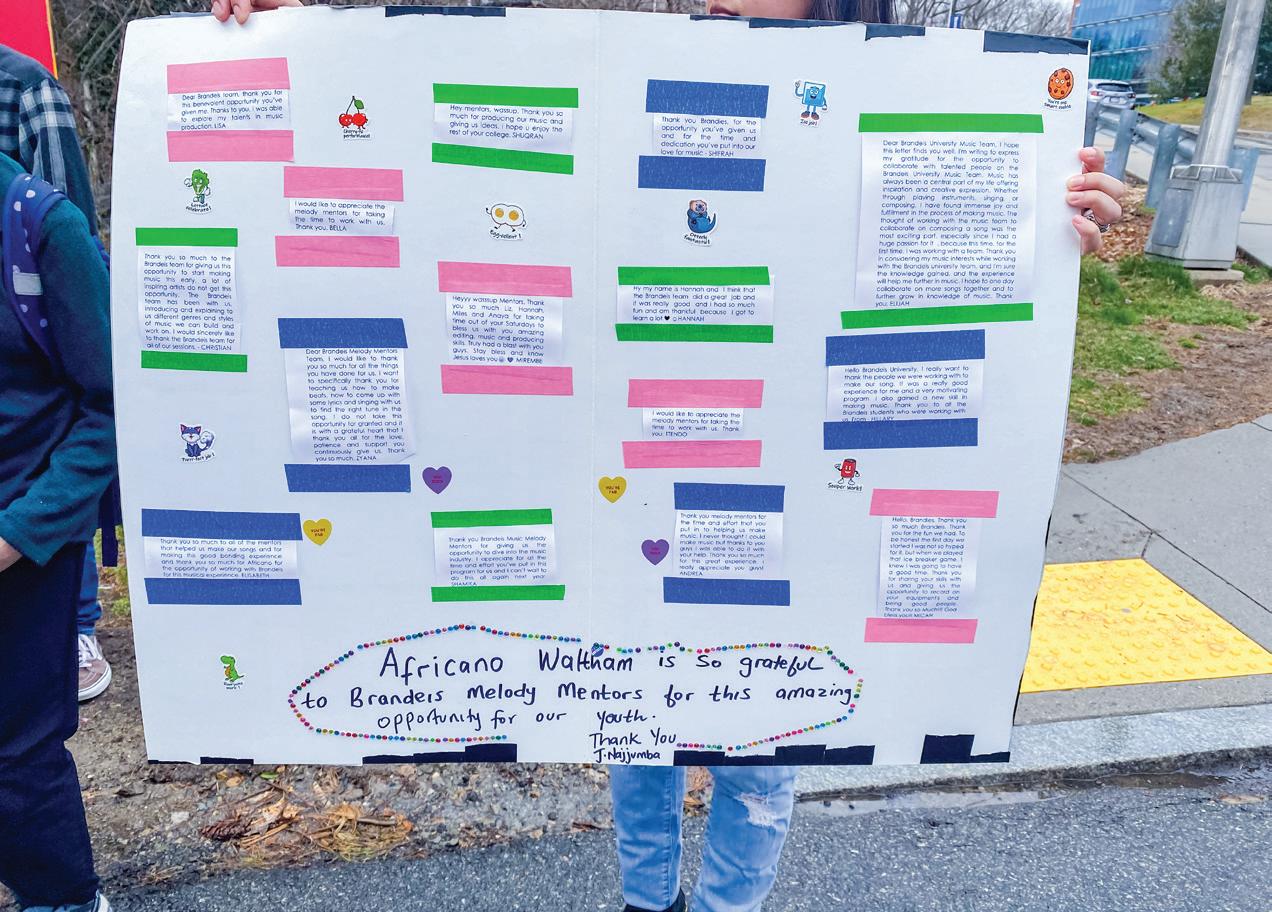

kind of song.” One notable lyric from the final product was, “Self Love is my ultimate power,” showing the different ways the Melody Mentors program allowed students to practice their passions and feel empowered through their projects. The Melody Mentors program also provides an empowering experience and learning opportunity for its mentors, including Ananya Dalal ’26. Dalal shared that it was their first year mentoring for Melody Mentors and they had found out about the opportunity through a friend in the program. “It’s a really cool experience because I haven’t mentored in music before. It’s cool to see how people bring in their different ideas to the table,” they stated. Menucha Krinsky ’24 shared that Sandoval had spoken about the opportunity at a COMPACT community engagement course and also had a friend as a board member which led her to join Melody Mentors. When asked about her favorite part about mentoring, Krisnky shared, “Exploring others’ musical desires and interests.” Jahkhai Waters ’26, shared that his favorite part of being a mentor was “getting to see kids happy or proud about the product” and the creative freedom in being able to suggest what they want to do with their songs. Lastly, Devyn Oh ’26 helps with lyrics, recording, and vocal editing. During their first year they worked with production, now working on sound editing. Oh hopes to come back for a third year if possible. “It’s just creative, people of very different backgrounds and experiences come together,” Oh shared about their experience mentoring. They also
talked about enjoying the time crunch: “You need to have something ready by this date. It’s not always the best but it’s definitely good to have that limit.”
At the end of the session, all five groups of students introduced themselves and presented their final products which began on March 2. Students chimed in to clap along with the song and hype up their peers’ work as they danced along to the music. Laughter filled up the room; “ooo’s” and “ayee’s” resounded after beat drops or in moments of genius. At the end of the program, mentees received copies of the songs. Sandoval is currently working with WuTang management for possible further development for the students’ work. For now, the board members of Melody Members are deciding if the songs will be shared on a platform like SoundCloud or elsewhere.
As everyone got up to leave the room at the very end of the session, Micah Kawere, a sophomore at Innovation Academy Charter School, took a moment to share her appreciation for the program: “On behalf of all of us (Africano Waltham), we want to thank you for everything. From the bottom of our hearts. I loved every single moment, it was amazing.” The students also presented the board members of the mentorship program with a handmade poster, which had notes of appreciation and praise for the program. One note read, “Dear Brandeis team, thank you for this benevolent opportunity you’ve given to me. Thanks to you, I was able to explore my talents in music production,” signed by a student named Lisa.
After rescuing his kidnapped and orphaned nieces and nephews, Mangok Bol is working with Brandeis faculty members to bring four of his late brother’s children from South Sudan to the U.S.
Program Administrator for Latin American, Caribbean and Latinx Studies and Department Coordinator for Chemistry Mangok Bol came to the United States in 2001 as a refugee of the Second Sudanese Civil War after having spent 13 years in refugee camps in Ethiopia and Kenya from the ages of nine to 22. He came to the U.S. as a part of the Lost Boys and Girls program, which resettled children who were orphaned or separated from their parents in the war. Bol’s story was covered in The Boston Globe, National Public Radio, The Justice and BrandeisNOW.
In 2014, Bol’s brother and sister-in-law were murdered in their village. Four of their seven children were kidnapped by the attackers. With the support of former United Nations ambassador Samantha Power, Bol was able to rescue Anyieth, Makuei and Ajoh and reunite them with their three siblings: Thon, Magot and Mach. The oldest niece, Abiei, remains missing. Mangok is hoping to welcome four of the siblings — Thon (now 21), Magot (now 17), Ajoh (now 15) and Makuei (now 11) — to the U.S. in the coming months.
After graduating from college, Bol joined Brandeis in 2008 as an Academic Administrator for International & Global Studies and Cultural Production. In 2012, he earned his Master of Arts in Finance from the Brandeis International Business School. He has become a beloved member of the Brandeis community and found the support of a group of academic administrators who are working to help Bol bring his niece and nephews to the U.S. The team consists of Lisa Pannella (ENG), Alexandra Brandon (WGS), David Devore (CEMS), Julie Seeger (PHIL) and Jennifer Stern (FA).
Preparing to bring the siblings to the U.S. has proven to be a complicated process, prolonged by various bureaucratic steps and new immigration policies following changes in office. The four had to qualify as refugees, go through a thorough vetting procedure and are still waiting to resettle. They are expected to arrive sometime over the summer.
In an April 12 interview with Bol, Panella and Seeger, Bol explained that he hopes to bring his family to the U.S. because of
By GRACE DOH JUSTICE EDITORthe lack of safety and resources available to them and the trauma they have endured from losing both parents. Bol went through a similar process with his niece and nephews when he left Africa, and he noted the abundance of opportunity that he found in the U.S. The difference, however, is that they will be coming to the states with the support of not only their uncle, but a whole community at Brandeis. He stressed his plans to provide them with opportunities like education, which he believes can be “life changing” for people of their circumstances. With the provisions they have made, Bol said, “I think they will do much better than I did.”
Presently, the four siblings have been approved to immigrate, have undergone cultural orientation and are now in the last steps of medical evaluation. The greatest concern regarding their arrival is securing housing in Massachusetts, which has proven to be a challenge with the state’s rising housing costs. Since around Thanksgiving of 2023, Team Mangok has been fundraising for the siblings’ living costs for the first few months of their transition. The group has raised about $26,000 — much of which has come from small donations by faculty and staff. It stood out to Bol that he and his family have the support of the entire Brandeis community because of his work. Seeger recalled that the furniture of a late former professor was donated to their cause. “Her children believed that she would be proud to give her furniture to Mangok’s family,” Seeger shared. It now sits in a storage unit as housing arrangements are being made.
Pannella spoke about how Team Mangok is made up of individuals who each bring their respective strengths to the effort. Her experience with government training for a different resettlement program informed her of the steps required in the four siblings’ resettlement case. Like Bol, Pannella too commented on the massive bureaucratic process that comes with trying to bring a refugee into the states. She explained that the two older brothers have to sign up for the Selective Service, and all of the siblings have to be set up with Massachusetts healthcare, Social Security and work authorization.


Seegar added, “We’ve got to acknowledge that Mangok is beloved by just about anybody whose path he has crossed. Anybody who knows Mangok is happy to roll over for him. He’s adorable, I mean, everyone loves him. We all want to help.” She remembered when they were just beginning to start fundraising and the organizers felt uncomfortable asking for money, someone told them, “You’re giving people the opportunity that they want because — like [Seeger] said — everybody wants to help.”
In a similar vein, Pannella shared that she feels fortunate to have the opportunity to help Bol’s family. “I think it is a moment to bring out the best in humanity. Mangok has seen the worst of humanity, twice.” Pannella noted the bombardment of negativity that exists in stories such as these, and Team Mangok has given people the chance to put positive energy out in the world: “I feel excited to be able to have this moment to be compassionate.”
Bol added that when he came to Brandeis, he approached it like any other job and expected to stay on for only a limited amount of time. He was not expecting to still be at Brandeis 15 years later, and he credits the environment, the students and his colleagues as the reasons why he stayed.
A child of a Brandeis community member once gave Bol $18, and he accepted this as a symbolic gesture of support. “There is something attached to that, you know. You are changing someone’s life,” he said. “People want to be part of something bigger.”
Preparing funds for housing and living costs are only the start of this great undertaking. Bol spoke of the great amount of trauma that his once abducted niece and nephew will have to process. They lived with their captors for over a year and are still battling the emotional aftermath. Bol recalled a moment when a doctor who was unaware of his niece’s past asked her if she had traveled to an area where she was exposed to a certain disease: “That made her cry because she was reminded of her abduction.”
Bol expects that this trauma will take years to recover from, but he believes
that a new environment will be especially helpful. “I think when she gets better counseling service, when she starts going to better schools, [has] a good network and [feels] safe and secure, she can achieve a lot here with her siblings,” he said. Bol stated that the U.S. has “some of the best opportunities for somebody who is looking for a better life. You can do a lot of yourself here when you have a space where you can feel secure.”
As a former Lost Boy, he’s been aware of the fact that some of the other young men who came to the U.S. through the program succumbed to alcoholism and substance abuse — a few even having gone to jail. In light of this knowledge, Bol says he will be especially involved in his niece and nephews’ upbringing, being especially conscious of protecting them during the transitional phase into their new life. The siblings seem, to Bol, to have mixed feelings about the move to the U.S., because they will have to start a new life away from people they have known since they were young. He hopes that when his niece and nephews come to the U.S., students in the Brandeis community will welcome them, mentor them and “help them get to know how it is here,” as they will be transitioning into a vastly different culture.
In other hopes for their future, Bol looks forward to living together as a family. Having had to raise them from afar as the sole male figure in their lives was a challenge for him. “It will mean the world to stay as a family, somewhere in Newton, and getting up and getting to the dinner table; doing things together,” he shared fondly.
From living alone in Massachusetts to suddenly becoming a guardian of four, Bol is prepared for an enormous adjustment. “He left his village when he was nine, and so to have a stable space and to have family members around is different for Mangok,” Pannella commented.
“When they come here I’m going to throw myself out there and be a parent,” Bol said, looking forward to being able to see the children grow and become people of their own.
Varsity athletes are arguably some of the most hard-working students of the Brandeis community. They balance being on an intercollegiate team, being full-time students, being involved in other areas on campus and often holding jobs. Despite being a selling point Brandeis highlights to prospective students, varsity athletes are not being adequately supported by the university.
Within the last few years Brandeis athletics has had a seemingly never-ending list of problems. Most recently this included the unpopular decision to reinstate the head coach of the women’s basketball team, Carol Simon, after she was suspended with pay during the investigation following reports of for racist behaviors. The Brandeis basketball teams have not had an easy few years with former men’s basketball coach, Brian Meehan, being fired in 2018 due to allegations of racism and abusive behaviors towards his players.
Another point of contention is the sorry state of the Brandeis softball field. In 2021 the Brandeis softball team was informed by former Vice President of Student Affairs Raymond Oh that their field would be rebuilt up to National Collegiate Athletic Association standards by October 2022. However, reconstruction has not yet occurred and the state of the field has reportedly worsened. Members of the Brandeis softball team have commented to The Justice in previous articles that the field is not equipped to deal with inclement weather, nor to practice on after dark, but most egregiously it is not up to NCAA size standards. This means that Brandeis is not able to host playoffs or tournament games, which has become a problem. The dugouts consist of chain-link fences with a tarp covering, which are not safe and put players’ health at risk.
Members of the softball team have commented in a previous article for The Justice that other schools have laughed at the condition of their field and that this was humiliating and embarrassing not only for their team but for Brandeis as a whole.
In discussing bad facilities it is hard to leave out the outdoor track. Similarly to the softball field, the poor conditions of the outdoor track make it so Brandeis is unable
to host any meets during the outdoor track season. The track is unsafe for athletes to practice on because it is littered with holes. This is incredibly dangerous for the track and field team who are required to practice on the track.
Poor facilities like these in addition to inadequate coaching discourages people from playing sports at the university. Many athletes stop playing sports at Brandeis or transfer to play at other schools. The lack of funding for varsity teams combined with substandard facilities and coaching deters prospective student-athletes from coming to Brandeis.
Varsity athletes are a part of the Brandeis community that deserves to be supported. This board would like to acknowledge the hard work of varsity athletes as well as the contributions they add to the community. This board condemns the improper treatment of Brandeis varsity athletes and encourages the University to improve both their treatment of their athletes and the facilities they have to practice on. We advocate for the administration to be more supportive of student-athletes during tough times.
While Brandeis is praised for its strong academic programming, students need more than just amazing professors to live successful and well rounded lives. One important aspect of a healthy lifestyle is physical fitness, something that college students often struggle to balance with academic pressures. This board would like to acknowledge some challenges faced by students who are not varsity athletes that try to maintain healthy lifestyles through the utilization of athletic spaces for both personal and club activities.
We would first like to address the state of the non-varsity weight room. On the way to this publicly available site, students walk past the well equipped and updated varsity weight room. The other weight room, available for all students and community members to use, is filled with broken equipment that creates an unsafe environment for those unfamiliar with it. The room is often crowded, as it is still one of the best places for physical activity on campus. Students are at risk of injury, and we urge the University to complete an update similar to the one seen in the Village Gym, allowing students a safer and more efficient fitness experience. While we are unhappy with the state of the weight room, we would like to acknowledge and support the addition of female-identifying only hours. These hours allow community members to feel more comfortable when entering the space and have diversified the users of the resource.
The board would also like to express concerns regarding the booking process of athletic facilities as a non-varsity organization. Not many spaces are available, and many groups are looking to use them.
For example, the dance organizations lost one of two main practice spaces and have had to instead book facilities such as Lindsey MPR4 for rehearsals. This is a shared space with both the ping pong and crew teams, causing scheduling conflicts, as only one activity can use the space at one time.
The dance space is limited due to the room housing both ping pong tables and stationary rowing machines. We urge the administration to reevaluate policies on the booking of places such as Spingold Theater dance studios, which are currently not available for club use. This would allow these organizations to be able to have more meeting times and, in turn, increase physical activity on campus.
There have also been issues, particularly in the winter season, regarding booking practices indoors. While varsity athletes are not able to practice outside, neither are club sports such as frisbee and quadball. Although they are not varsity, these teams spend this season practicing to prepare for their match -
es against other schools. This board understands that the administration appreciates when teams do well and often use it as an element of promotional material for the University. We encourage them to work on supporting all organizations, giving everyone an equal chance to thrive.
Even when the outdoor fields become available, they are often not safe for students. The club field, utilized by many teams, is not level, which often results in the pooling of water and large amounts of mud that are not safe for those participating in physical activities. The lights on the club fields are also not sufficient, as they are not easy to utilize and are not always functional. As many club sports practice following the conclusion of the day’s classes, a well-lit field is required for the safety of all involved. We call on the University to acknowledge the importance of health, and encourage students to get involved in the diverse athletic opportunities that the community has created. We request that all teams, no matter the level, have practice


Climate change stands to impact every facet of our daily lives; from the water we drink, the communities we build, tourism, migration, etc. It is crucial for media outlets to keep the public informed, but the coverage has to be productive. It shouldn’t leave its readers in a state of paralysis or fear.
According to “Influencing Audience Perceptions: How Fox News, CNN & MSNBC Portray Climate Change in 2019” by Grace Meekin, Cable News Network has a signature style when it comes to addressing the climate crisis. When examining quantitative results from Meekin’s data collection, she found that CNN utilizes imagery of rapid melting ice in Alaska, the displacement of people after environmental disasters, and the wildfires across the West Coast on their social platforms as well as in their live broadcasts.
Additionally, they refer to climate change exclusively as the “climate crisis” Meekin notes that replacing the word “change” with “crisis” emphasizes the urgency and severity of the matter. Titles of articles on their website range from “Deadly Texas wildfire torches 1 million acres…” to “The climate time-bomb is ticking’: The world is running out of time to avoid catastrophe...”. Reporters have also stressed the responsibility that we have today to decrease the impact of climate change for the wellbeing of future generations. Chad Myers, a severe weather expert for the outlet, stated during his “What you can actually do to slow the climate crisis” segment that “your grandchildren are depending on you.” It is evident that CNN is working diligently to inform and warn people about the impending climate crisis with an emphasis of doom and gloom. This style of report-
By LAURYN WILLIAMS JUSTICE DEPUTY EDITORing global warming entails discussing a feeling, atmosphere or sense of despondency which may not be best serving the American public.
The National Institute of Health highlights a growing concern surrounding climate anxiety. This refers to a “heightened emotional, mental or somatic distress in response to dangerous changes in the climate system,” which can manifest itself as a sense of hopelessness, grief, anger, guilt and existential dread. According to a survey conducted by the Yale and George Mason University Program on Climate Change Communication, one in 10 Americans report experiencing anxiety because of global warming. Furthermore, climate concerns are significantly higher among young people. These feelings have negatively influenced their everyday lives, including their ability to concentrate, eat, sleep, study and enjoy their relationships. This can lead people to limit the climate news they consume or stop staying informed all together to mitigate their anxiety.
In direct juxtaposition, journalists who seek to produce more well-rounded coverage about climate change have created their own advocacy oriented media organizations. Heated, a newsletter created by Emily Atkin, stands out as it strives to provide accurate and nuanced perspectives about the climate crisis. In Emily’s own words, “It is not your fault that the planet is burning.”
“Your air conditioner, your hamburger, your gas-powered car — these aren’t the reasons we only have about a decade to prevent irreversible climate catastrophe. No; the majority of the blame for the climate emergency lies at the foot of the greedy; the cowardly; the power-hungry; the apathetic.” Heated’s main goal
is to empower the public and remind readers that no individual can solve the climate crisis on their own. Instead of only having titles related to catastrophe that feel intangible, the publication highlights how climate change can apply to an array of topics with articles such as: “There’s no such thing as a climate-friendly Super Bowl,” “This is all the gas industry’s fault,” “Here’s how much Democrats get paid to shill for fossil fuels,” and “Yes, climate activism can win.” Heated has an article for almost everyone, and it does not shy away from holding both Republican and Democratic leaders and corporations accountable for their role in climate change. Additionally, because it is not a mainstream publication, it elicits personal interactions with the readers.
People are able to reach out and have a direct conversation with Emily or her team members, which makes them feel like they are a part of a vigilant community for change instead of a helpless onlooker. One article that stood out to me was “How HEATED readers are moving the needle.” It detailed how a reader was moved to action after reading an article detailing how a powerful lobbying group was obstructing climate policy across the country. This reader reached out to organizers across San Mateo to halt the lobbying group’s efforts, and was able to mobilize countless others to protest. Emily opened up the article’s comment section for her entire readership to organize local climate activism in their own communities. People expressed that they actually felt empowered, and swapped advice on how to get involved in the fight against climate change.
It is important for news outlets to accept the fact that information and communication hold
immense potential to enhance our lives and societal well-being. However, legacy news outlets have also emerged as a fertile ground for aggravating polarization and posing a threat to societal harmony. Pew Research uncovered exactly this concern. They conducted a series of interviews that found that language describing climate change as a crisis or an urgent threat caused suspicion amongst participants. Interviewees expressed distrust in national news to provide credible information surrounding climate change.
One participant, a man in his late 40’s from the South, expressed his belief that “Networks and radio and newspapers and television, they’re all getting paid to tell me something. And if they don’t have my attention then they’re not getting paid. So they’ll do whatever they need to get my attention… It’s all about ratings and, you know, getting people to watch.”
Additionally a woman in her mid 30’s from the Midwest echoed a similar sentiment, stating, “From a personal standpoint…when the statements are, ‘The world is getting warmer and Earth is going to be ended in five years because we’re all terrible humans and we throw trash on the ground.’...instead of causing me to be concerned, it causes me more climate anxiety and skepticism about where the information is coming from and why it’s being presented in such a grandiose term, for lack of a better word.”
Audiences are best served by the approach of advocacy-oriented outlets where they can have direct influence on the content instead of legacy partisan based outlets whose approach is shock and awe.





■ Stanford’s coaching icon retires, leaving a lasting impact on women’s basketball.
By BENIE COHEN JUSTICE STAFF WRITERAfter an illustrious 45-year coaching career, Tara VanDerveer, the National Collegiate Athletic Association’s winningest basketball coach, with an extraordinary 1,216 victories, has announced her retirement on April 9, leaving a legacy that transcends the bounds of collegiate sports. Stanford University, where she crafted champions, made the official announcement, marking the end of an era in women's basketball.
VanDerveer's journey through the hoops of history is one adorned with achievements that cement her as one of the most influential figures in the sport. Across her 38 seasons at Stanford, she secured three national championships, lifting the trophy in 1990, 1992 and 2021. Her teams became synonymous with excellence, gracing the Final Four stage of the NCAA March Madness tournament a remarkable 14 times.
Before coaching at Stanford, VanDerveer coached at Idaho State University from 1978 to 1980 and at Ohio State University from 1980 to 1985 where she served as head coach for a combined seven seasons. At Ohio State, she accumulated a 1,216-271 (.818 winning percentage) record in her 45 years as a collegiate head coach. At Stanford, she continued her impressive legacy, amassing a 1,064220 (.829) record over 38 seasons.
But her impact extends beyond mere statistics; VanDerveer's coaching philosophy was a beacon of positivity and energy, shaping not just studentathletes but individuals who were primed for success both on and off the court. Her accolades, from being enshrined in both the Naismith and Women’s Basketball Halls of Fame to earning five national Coach of the Year titles and 18 Pac-12 Coach of the Year titles, underscore her unparalleled contributions to the game.
The 2020-21 season epitomized VanDerveer's ability to navigate challenges while maintaining a winning culture. Amidst the turbulence of a global pandemic, she steered Stanford to a pristine 31-2 record, clinching both the Pac-12 regular season and tournament championships before ultimately seizing the national crown. Her leadership during these trying times showcased not only her tactical prowess but also her unwavering commitment to her players' well-being.
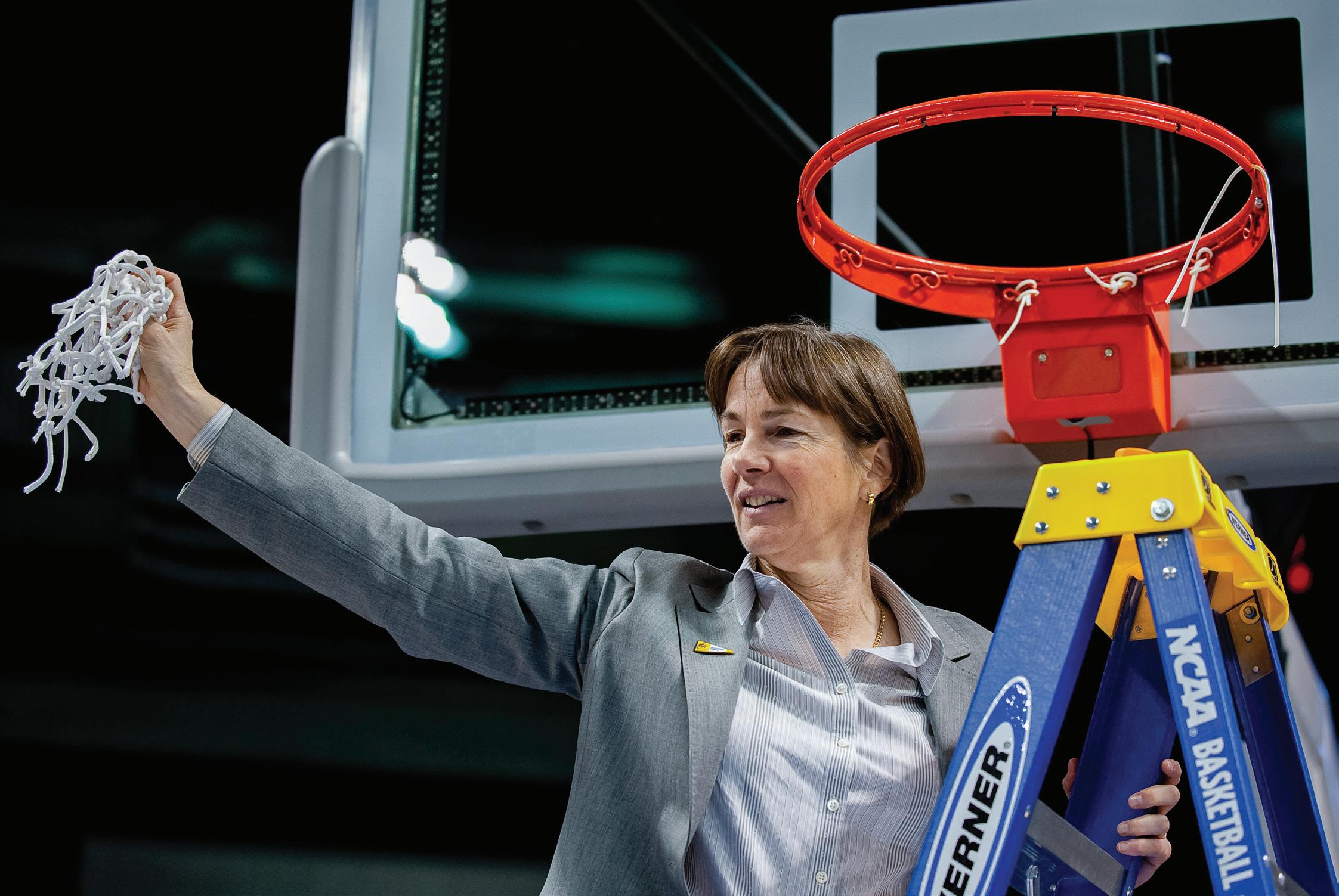
VanDerveer's impact reverberates through the lives of the players she has mentored. Under her tutelage, Stanford athletes soared to unprecedented heights, earning numerous accolades and championship wins. Her emphasis on holistic development paved the way for her players' success both on and off the court — many going on to excel in the professional arena, including the Women’s National Basketball Association Beyond her coaching prowess, VanDerveer's legacy is intertwined with her role as a trailblazer. She shattered barriers, becoming a beacon of inspiration for aspiring coaches, especially women, across the globe. Her tenure as head coach of the United States of America Basketball National
Team, culminating in an undefeated Olympic gold medal run in 1996, further solidified her status as a titan of the game.
Off the court, VanDerveer's multifaceted persona shines through. A graduate of Indiana University and an accomplished pianist, she embodies a blend of academic rigor, artistic passion and athleticism. Her book, "Shooting From The Outside," offers a glimpse into her journey, capturing the essence of her Olympic and national team experiences.
As VanDerveer bids farewell to the sidelines, her legacy endures as a testament to the transformative power of sports. Her influence transcends wins and losses, embodying the essence of per-
severance, integrity and excellence. While her departure marks the end of an era, her indelible imprint on the world of basketball will continue to inspire generations to come.
In the wake of VanDerveer's retirement, the prospect of Kate Paye, a former player under VanDerveer's wing, potentially succeeding her underscores the enduring legacy of a coaching dynasty built on a foundation of passion, dedication and unwavering commitment to greatness. As Stanford embarks on a new chapter, the spirit of VanDerveer's legacy will undoubtedly continue to shape the future of women's basketball for years to come.

Brandeis Softball took on Emory University in conference play this past weekend and hosted a Pride Game on Sunday. The Judges fell to the Eagles but then bounced back with two strong wins against the Worcester Polytechnic Institute on Monday.
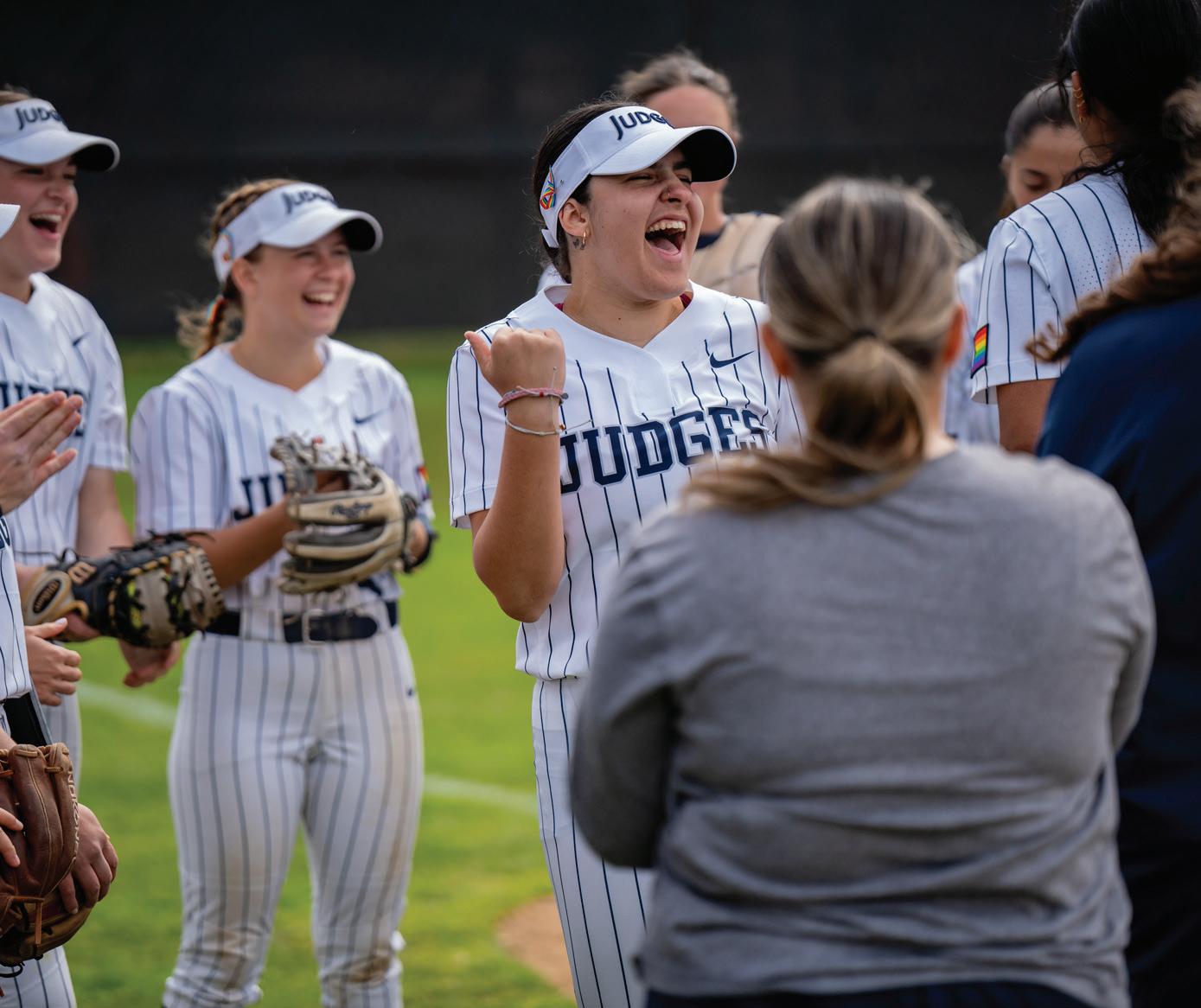

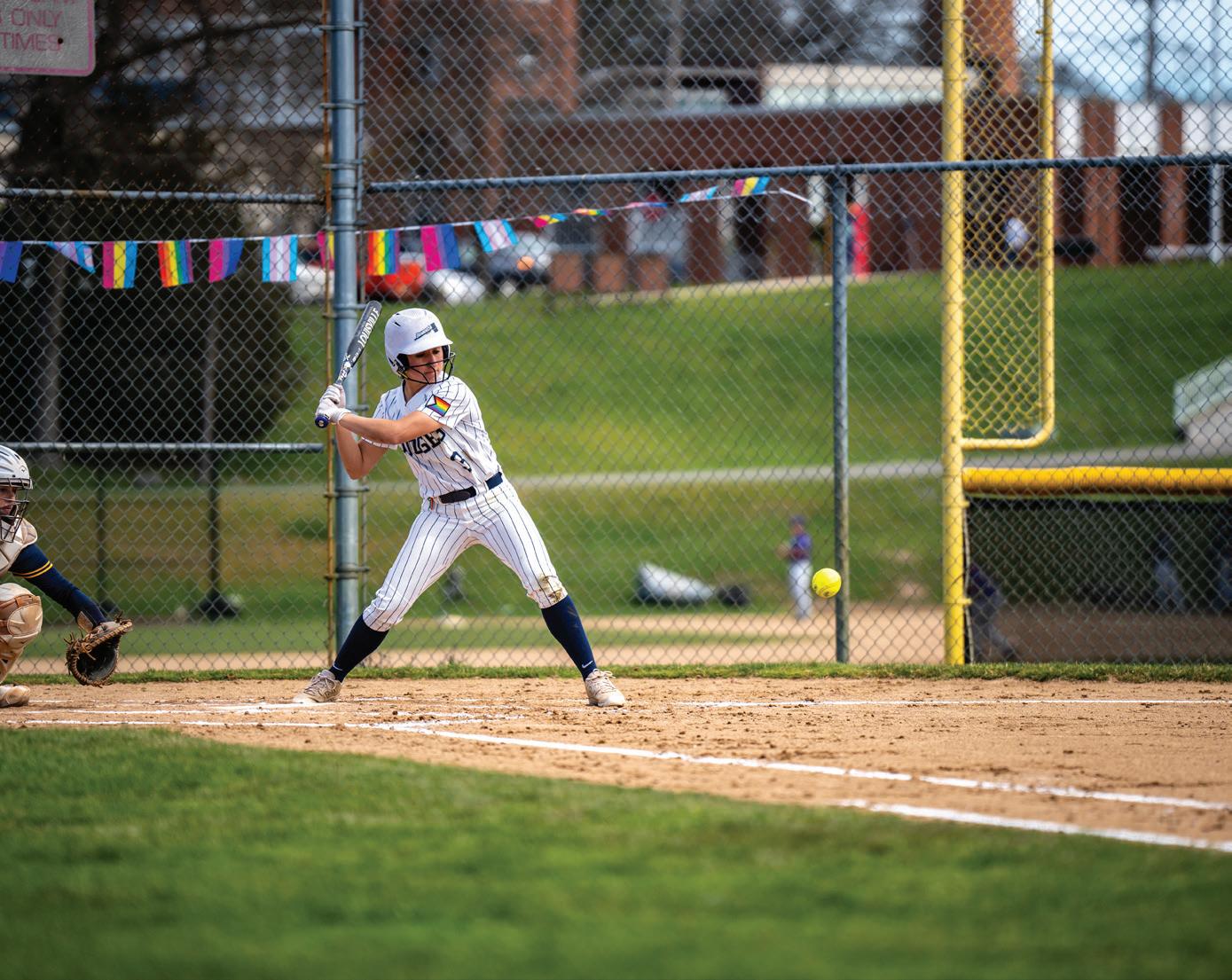

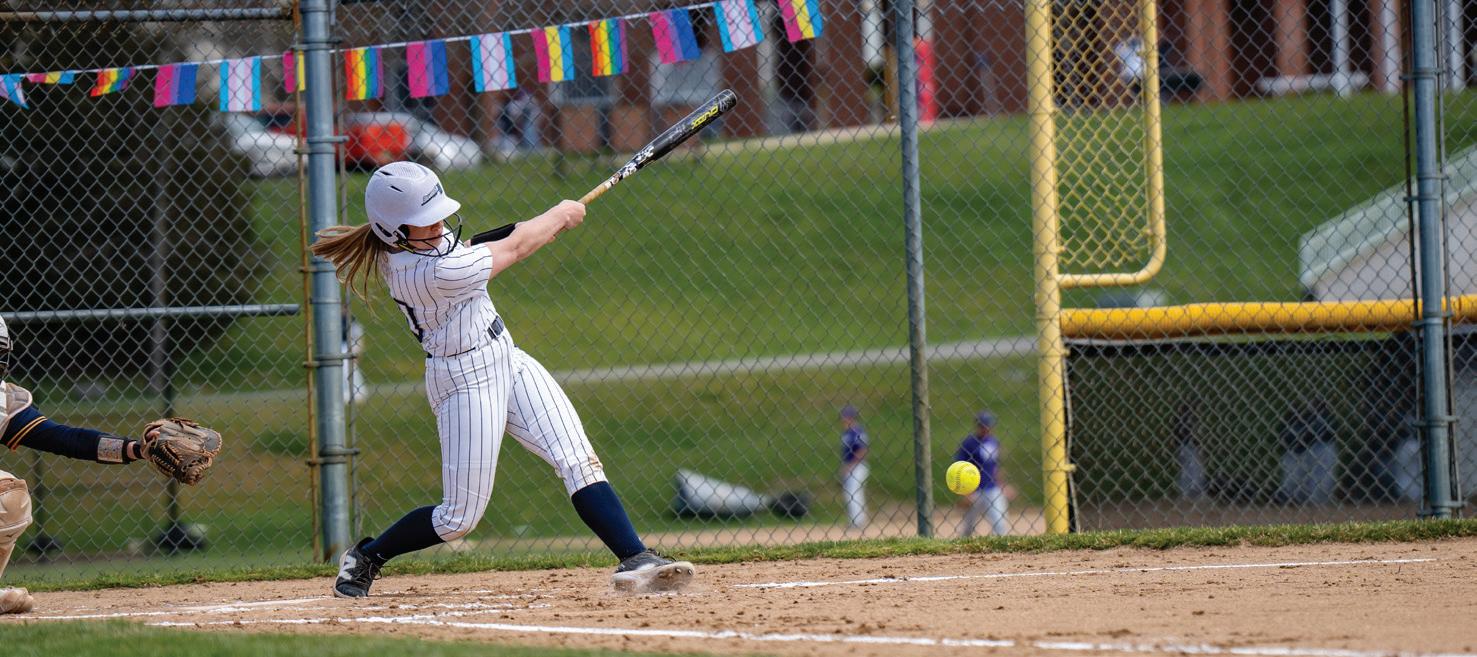
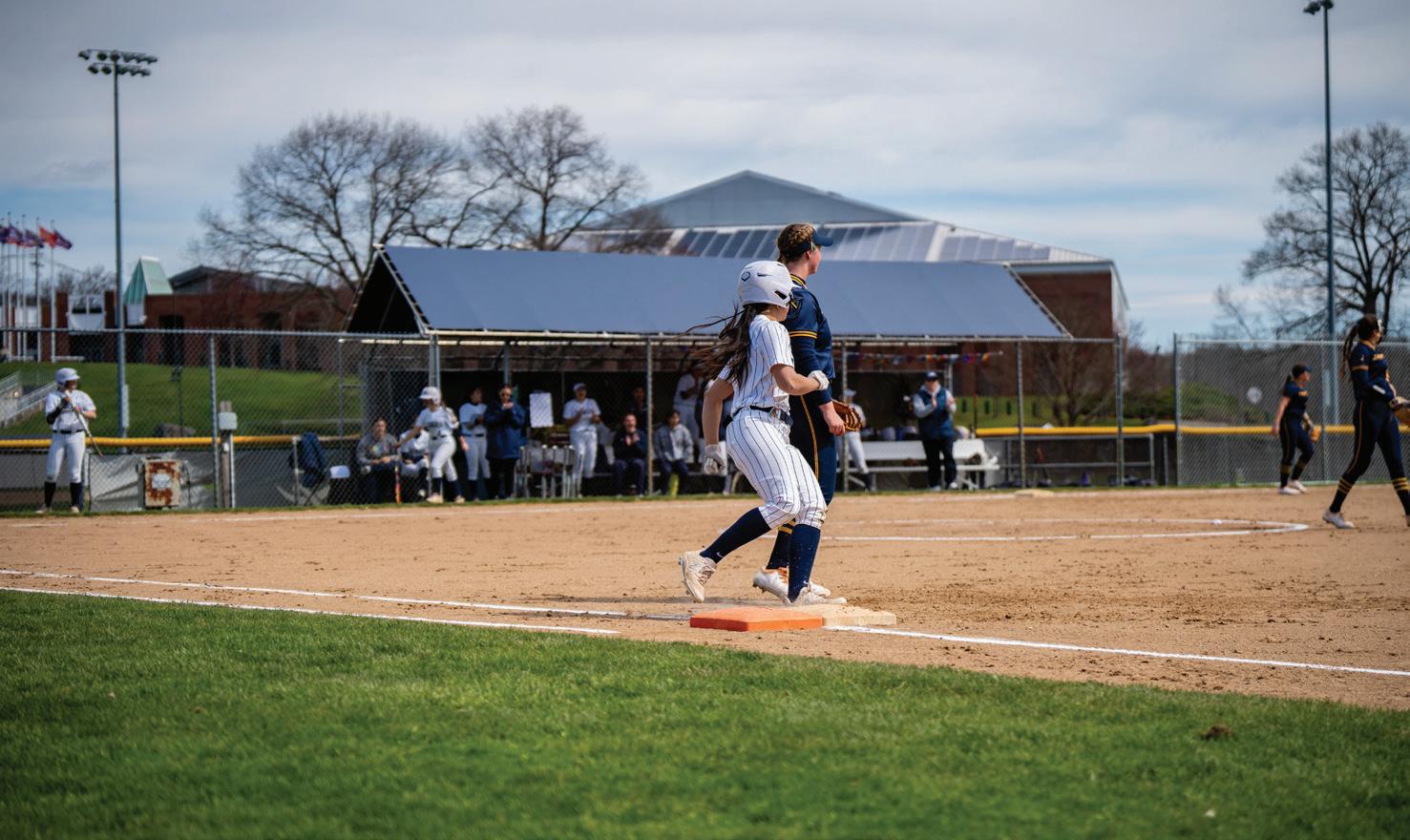




UPCOMING GAMES: Results from the Carla Coffey Invitational .

MEN'S TOP FINISHERS
MEN'S UPCOMING MATCHES: STANDOUTS Singles Dylan Walters '24 leads the team with a record of 15-7. Doubles

WOMEN'S TOP
Bhakti Parwani '25
showing on the clay and gained valuable match play.
Another member of the big three Rafael Nadal has dominated on clay for years. The Spaniard has won a total of 22 majors with 14 of them being at the French Open. Nadal won his first French Open in 2005 and has continued to have great success on the surface. He has been called the “greatest clay-court player of all time.” However, Nadal has been out of the game for around a year due to hip flexor injury, and he plans to retire following the 2024 season. He continues to pull out of tournaments but hopes to participate in the Barcelona Open in mid-April. Nadal’s showing at this tournament will hopefully give more insight into his potential at the French.
Another Spaniard, Carlos Alcaraz must be included in the discussion on possible French Open winners. Although he is only 20 years old and does not have the astounding record that Djokovic and Nadal have, Alcaraz has begun to make a name for himself in the tennis world. In fact, he is projected to win this year’s French Open based on data from several sports betting apps. While he has not won the French Open in the past, Alcaraz has been called a “clay specialist,” which makes him someone to watch in the upcoming tournament.
Another young, up-and-coming
player, Jannik Sinner, also has the potential to do well at this year’s French Open. At 22, he’s coming off a major win over Djokovic at the Australian Open. Like Djokovic, he has also made it to the semi-finals at Monte-Carlo, indicating that he is on level playing ground with the all-time great.
If the men’s draw is up in the air, then the women’s draw is even more so. While the men’s tennis world has had consistent winners for many years — namely the Big Three — the women’s side has been lacking these long term standouts in the past few years. Of the last 15 French Opens, 14 were won by one of the Big Three. However, on the women’s side, there has been more variation with the winners. Yet Iga Swiatek has won the last two French Open titles, making her a favorite to repeat her victory.
At the age of 22, Swiatek has won four grand slam titles, three of which have been at the French Open. She first won a grand slam title in 2020 at the French Open, despite her low ranking of 54th in the world. Through this win, Swiatek became the lowest-ranked player to win the French Open. She’s won the French the last two years, so she is certainly a favorite moving into the tournament. However, there are plenty of women who could take the title. While the hard court is not her best surface, Swiatek has won one U.S. Open title. However,
in the 2024 Australian Open, she went out in the third round after losing to Linda Nosková in three sets, showing that she could be beaten.
Aryna Sabalenka could easily outplay Swiatek and take the title. Sabalenka won the previous two Australian Open titles and was runner-up in the 2023 U.S. Open. She has a lot of momentum and confidence as she moves into the French Open. While clay may not be her favorite surface in comparison to the hard courts, Sabalenka defeated Swiatek on clay last year at the Madrid Open to win the tournament, proving that her skills can transfer well onto the clay surface.
Another player to watch is Cori “CoCo” Guaff. Similar to Alcaraz, Gauff is 20 years old and making a name for herself on the women’s tour. In the 2023 U.S. Open, Gauff defeated Sabalenka in the Finals, thus winning her first Grand Slam title. While she has not won a French Open title, she did make it to the finals in 2022. Although still developing her skills as a young player, Gauff has proven herself to be in the running to win this year’s French Open.
There is still about a month before the first match is played at Roland-Garros, but the players are hard at work matching and preparing for the next Grand Slam. There’s no telling what the outcome will be — all we can do is wait and see.



she’s played at Brandeis. The women’s team is 13-14 for the season, Nash’s fourth and final with the team. This Friday, Saturday and Sunday the Judges will play in a fourgame conference series at home versus Case Western Reserve University.
— Editor's

■ The Brandeis softball senior, third baseman and catcher was named to the National Fastpitch Coaches Association Player of the Year watchlist for her defensive and offensive performance this season.
By MILES GOLDSTEIN JUSTICE STAFF WRITERHaley Nash ’24 of the Brandeis women’s softball team was named to the National Fastpitch Coaches Association Division III Player of the Year watchlist on April 4. The NFCA will announce the winner following June 7 when Division III seasons conclude. The yearly award recognizes the top pitcher and position player in Division III softball. The NFCA released a list of players to watch heading into the final leg of the season, as it's likely the eventual player of the year will be selected from this list. Nash’s selection to the watchlist should come as no surprise to anyone who's been following the Judges this season. In 27 games, so far, she has a team-best .363 batting average, leads the team in home runs with eight, and
trails only Bells Burdenski '26 for most runs batted in with 24. Conferencewide, Nash ranks second and seventh in those two stats, respectively. Her discipline has seen her accrue 20 walks, second most in the conference, and only 14 strikeouts. She also leads the conference in slugging percentage, or total bases divided by at-bats, at .763, which ranks in the top 100 for all of Division III softball. Nash has the sixth all-time highest career slugging percentage in school history. She’s been a steady glove on defense, splitting time between third base and catcher.
This year she has reached base in 23 games, including a 10-game streak to open the season and has had two fourgame stretches where she recorded a Run Batted In in every game. She drew eight walks in six games at the end of March and beginning of April, hit home runs in back to back games in mid-March against Wentworth Institute of Technology and had an 11game stretch with a perfect fielding percentage earlier in the year. She has managed to stay consistent throughout the season while also putting together some electric stretches throughout the season to propel her team to wins.
This nationwide recognition came at a fitting time. Nash recently crossed the 100-hit mark for her career. As of
■ As the French Open approaches, The Justice shares our predictions of who will take the title in one of tennis’ most prestigious tournaments.
By JULIA HARDY JUSTICE ASSOCIATE EDITORFrench Open starts in late May; Wimbledon is in June; and the U.S. Open closes out the season from late August into September.
As we move through April, the French Open is quickly approaching. The French Open is held at RolandGarros in Paris and is the only Grand Slam tournament played on a clay surface. This is an important component of the tournament to note, as the courts tend to cause longer rallies because the ball is weighed down by clay when it hits the ground.
While the tournament is more than a month away with a start date of May 26 for the main draw, players have already started training and playing matches on clay.
Based on the lead-up tournaments
and players’ past records, specialists have already begun to make predictions. However, as someone who has watched Grand Slam tournaments for the majority of their life, I have some opinions of my own. While it’s early for predictions, there is an abundance of information to rely on to make educated guesses.
Starting with the men’s side, Novak Djokovic is the defending champion, having won the tournament in 2023 after defeating Casper Ruud in straight sets. Djokovic is one of The Big Three, joined by other tennis greats Roger Federer and Rafael Nadal. These three men have dominated the men’s tennis tour for nearly two decades. Djokovic himself has won a total of 24 major titles. With his history, combined with his win in 2023, Djokovic is always in the running to win a major.
Djokovic is often one of the favorites leading up to any major tournament, but clay has not been his favorite surface in the past. He has won only three French Open titles, which is a small proportion of his overall grand slam wins. Additionally, Djokovic failed to clinch a victory in the last grand slam tournament of the year — the Australian Open — against Jannik Sinner, indicating that he perhaps has not been at his best as of late.
However, Djokovic seemed to be in relatively good shape at Monte-Carlo, a prestigious Association of Tennis Professional Masters 1000 tournament.
Djokovic made it to the semi-finals, defeating Alex de Minaur in straight sets. However, he fell to Casper Ruud in three sets. While he didn’t make it to the finals, Djokovic made a strong
Softball posted a loss against the Emory University Eagles in the Judges' Pride Game, p. 14.
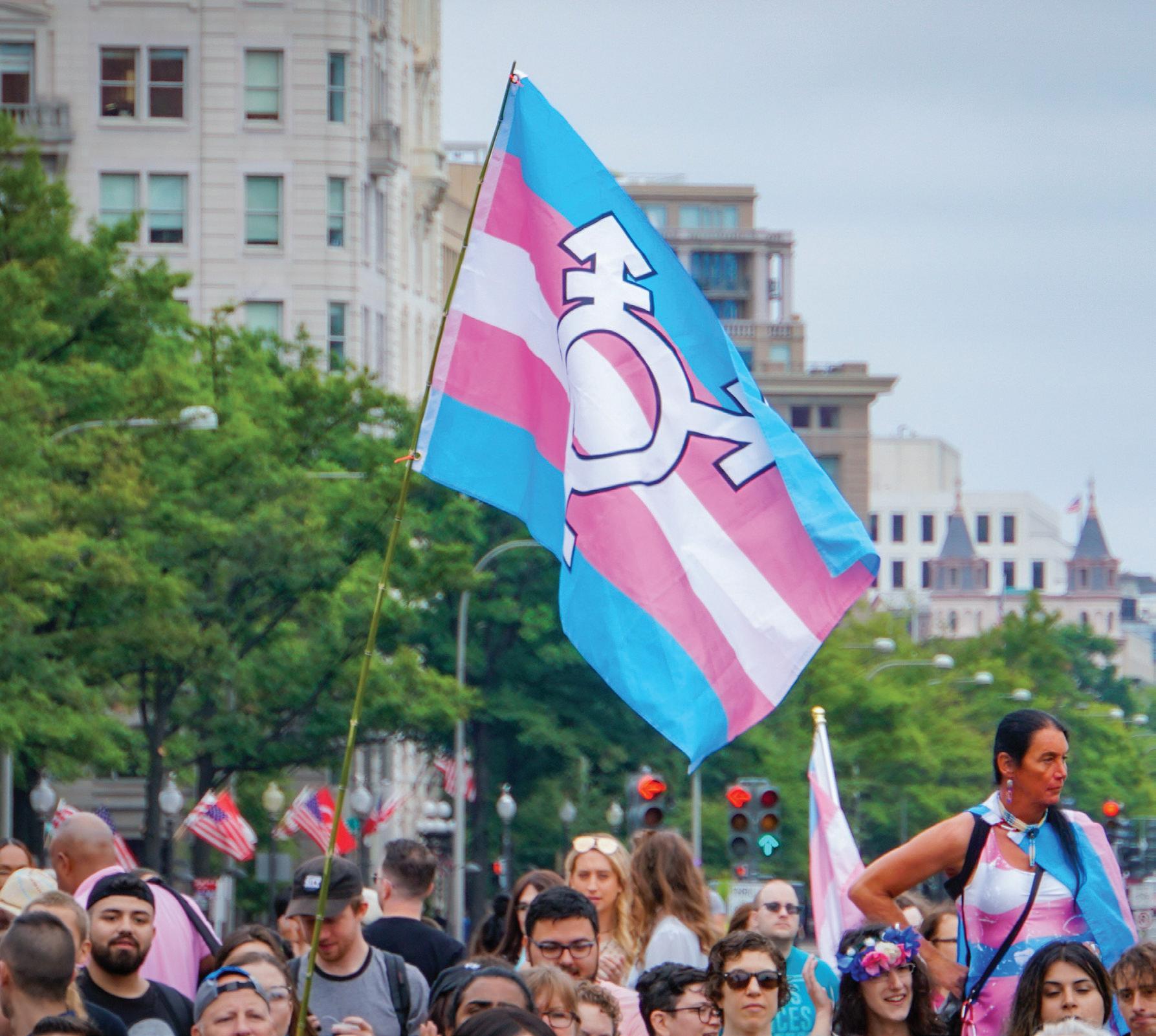
■ The National Association of Intercollegiate Athletics has recently released a new policy that negatively impacts transgender student-athletes hoping to participate on women’s teams.
By ANNA MARTIN JUSTICE EDITOR IN CHIEFThe National Association of Intercollegiate Athletics released a new policy on April 8 regarding transgender male-to-female student-athletes that comes close to preventing any of them from participating on women’s teams. The NAIA is comprised of 241 small colleges across the United States and oversees approximately 83,000 athletes.
The NAIA Council of Presidents voted unanimously with a final count of 20-0 to pass this new policy. This vote took place at the organization’s annual convention in Kansas City, Missouri. This new policy states that all students may compete in NAIA sports designated for male student-athletes, but only those assigned female at birth who have not begun any variation of hormone therapy are allowed to participate on teams designated for female student-athletes.
Those students who have begun hormone therapy can find a place on
the team within activities such as workouts and practices but are not permitted to participate in interscholastic competitions. However, a few sports are exempt from this new rule. Competitive cheerleading and competitive dance have not been subject to this policy due to them already being designed as coeducational and open to all students. In a statement to the Associated Press, the NAIA stated “Each NAIA sport includes some combination of strength, speed and stamina, providing competitive advantages for male student-athletes.” They believe that this advantage is only applicable to teams specifically separated by the gender of participants.
The NAIA also stated, “The NAIA understands that legal action being taken to challenge the policy is a possibility, but this policy is one our membership and board felt like was the right decision.” The policies regarding transgender athletes' ability to participate in collegiate interscholastic competitions have been on the minds of many recently, as the National Collegiate Athletics Association recently released a plan to update their policy, placing themselves in line with the U.S. Olympic and Paralympic committees.
Senior counselor of the National Women’s Law Center, Shiwali Patel, has expressed that the organization is outraged by the new NAIA policy. "This is unacceptable and blatant discrimination that not only harms trans, nonbinary and intersex individuals, but limits the potential of all athletes," Patel stated.
Following the release of the new pol-
icy from the NAIA, the NCAA released a statement. This statement is as follows: “College sports are the premier stage for women's sports in America and the NCAA will continue to promote Title IX, make unprecedented investments in women's sports and ensure fair competition for all studentathletes in all NCAA championships.”
According to an article published by National Public Radio, “The Biden administration originally planned to release a new federal Title IX rule — the law forbids discrimination based on sex in education — addressing both campus sexual assault and transgender athletes. Earlier this year, the department decided to split them into separate rules, and the athletics rule now remains in limbo even as the sexual assault policy moves forward.” These policies have had effects at colleges all over the country, including our own. The Brandeis Athletics department’s transgender student policy is in line with the recently updated NCAA’s and has not received backlash to date. The department and NCAA acknowledge the timeline with testosterone treatment and appropriately form their statements based on the cadence of treatments for studentathletes.
For female and transgender athletes, it has been an eventful month with the release of both policy changes and the increasing politicization of the issue. These governing bodies hold a great deal of power in terms of what the future holds for transgender women in sports.

From Thursday, April 4, to Sunday, April 7, Brandeis’ Hold Thy Peace presented their version of William Shakespeare’s “The Tempest,” directed by Naomi Stephenson ’26. “The Tempest” is an incredibly fascinating and nuanced piece of literature, telling the story of one man’s quest for vengeance and those he impacts along the way.
For starters, the actors and dancers did a wonderful job bringing the show to life. Particular performances we enjoyed were the roles of Miranda, Prospero and Caliban. In “The Tempest,” Miranda is the young, innocent daughter of Prospero. Abby Tang’s ’26 portrayal of the character was well refined and emotional. She skillfully presented the difficult Shakespearean prose and fulfilled the role of Miranda incredibly well. Prospero, the exiled Duke of Milan, was played by Laurel Kane ’26, who approached the character in a unique way. Bending the portrayal of gender in this way added a level of depth and consideration to Miranda and Prospero’s relationship. Kane’s acting created an intensity and a virility to the newfound maternity of the protagonist. Her presence on stage showcased the dignity and respect that Prospero’s character desires and obtains at various stages in the piece. JT Dickstein’s ’27 showing of Caliban, an islander who Prospero enslaved, was intense and clear. It is not often that a Shakespearean actor can deliver the prose and lyricality of the author in an approachable manner of tone, clarity and deliverance. Dickstein’s performance was one of the most approachable and understandable to an inexperienced appreciator of Shakespeare. Another key component of this production was the choice to include dancers to portray the spirits of the island. The collaboration between HTP and multiple dance groups on campus allowed the performance to take on an elegant direction, adding a new depth to select scenes. Their light and airy movements in conjunction with the whimsical choreography of Irina Znamirowski ’24 beautifully emulated the magic of the spirit Ariel. Between the fantastical elements and difficult prose, Shakespeare’s “The Tempest” is not an easy production to put on. However, the performers involved approached their roles with a comfort and grace that elevated the production.
That said, we believe that this production took a directional misstep. The play, as it was on stage, had certain moments of insensitivity and misplaced humor. These moments detracted from the performances of the actors and dancers. In addition, these moments led us to reflect on the reading of the play and the broader message expressed.
One of the first and most important introductions to any play is the program. It provides context — which is especially important for Shakespeare plays — and cast and character introductions, but it also gives insight into the direction and reading of the play. Further, the reading and direction of a play can directly change and develop new understandings of characters and themes present in the existing text. Programs carry important context for a production, and “The
Tempest” is no exception. In fact, the program seems to be a vital text in order to understand this director’s reading of the play. In this program, Director Stephenson proposes a new interpretation of the piece, as well as two prior readings. The first reading centers around the character of Prospero, specifically the themes of vengeance and redemption in both political and personal relationships, as his character reclaims his dukedom. The second, more modern reading deals with the theme of colonization. It is here that we the authors give a warning to our readers regarding potentially triggering topics, such as colonization, racism, orientalism and their places in history. The second reading focuses on Caliban’s character, specifically his indigeneity to the island and servitude under Prospero. These two characters have an incredibly fraught and complicated relationship throughout the text. In this reading, Caliban is read as the Indigenous character as he was born on the island. Sycorax — a witch from Algiers, the capital of modern day Algeria, who is also Caliban’s mother — was banished to the island. There, she gave birth to Caliban and trapped Ariel, a nature spirit of the island, in a tree. From this perspective, Caliban takes on the role of the colonized and Prospero is the colonizer.
Director Stephenson’s reading positions a different character in these roles. According to the program, Stephenson used her past experiences playing Ariel to inform this new direction. As stated in the program, “If it is Ariel, rather than Caliban, who is the true indigenous resident of the island, the play becomes infinitely more complex. It gives Caliban the complicated status of being both colonized and a wannabe colonizer. And it means that Prospero’s redemption is directly sparked through the island’s indigenous residents.” In this production, Ariel is the colonized and Caliban is both colonized and a colonizer.
This reading presents two major flaws. The first, more concrete flaw is a fundamental reduction of key parts of the text as they relate to Caliban. The second relates back to stereotypes and prejudice of Indigenous communities and the larger concepts of indigeneity and colonialism.
As indigeneity is a consequence of colonialism, it is essential to define colonialism first. Colonialism, as is defined throughout multiple contexts, encompasses the political control of a land or territory, primarily through the exploitation of people and resources. In this instance, colonialism takes on a systematic and oppressive context. Indigeneity, as a concept, is only possible after colonialism. It is the quality of a group, individual or practice that is native to a place, citing specifically culture and heritage, with one key aspect being language. Another important aspect of indigeneity is its connection to European colonialism. The Oxford English Dictionary acknowledges the explicit place of European colonizers in the definition of indigeneity, because indigeneity is often used to describe exclusively Indigenous Americans and Aboriginal Australians. Extending this definition to
MAEVEother groups requires the understanding of commonality between Indigenous Americans and Aboriginal Austrialians and other situations. What is common between the two and “The Tempest” is the specific removal of culture. Through the acquisition of land, colonists rejected and dismantled Indigenous cultures by enforcing aspects of Western culture. “The Tempest” is no different. It is the language of Caliban that is imposed on him by the presence of Europeans, Prospero and Miranda from Milan.
With the meaning of indigeneity established, it is important to consider the displayed characterization of Prospero, Sycorax, Caliban and Ariel under the program’s interpretation of the text. Prospero, the Duke of Milan and the protagonist of “The Tempest,” takes on an interesting characterization and contrast to the third reading shown in the program. This refers to Caliban and Ariel as enslaved. However, it never positions Prospero himself as a colonizer. While he is previously considered a colonizer during the synopsis of the colonial reading, it is unclear whether that positionality was extended to Stephenson’s reading, especially considering the onstage performance did not communicate a colonial theme through Prospero. This non-colonial portrayal of Prospero makes sense given the implication that Sycorax is the original colonizer in Stephenson’s reading. Sycorax, mentioned once throughout the play, was Caliban’s mother, banished to the island due to her witchcraft. According to Stephenson, the importance of Sycorax is that she established Caliban’s claim to the island. As aforementioned, Caliban represents both “the colonized and a wannabe colonizer” in this reading of the play, while Ariel is established as the “true indigenous” inhabitant of the island. As viewers and appreciators of “The Tempest,” we are not in agreement with this direction. Especially given the onstage presentation and the interpretation of Prospero, Caliban and Ariel throughout the piece, certain aspects read as historically insensitive and racially prejudiced.
It is true that the interpretation of “The Tempest” where Caliban is explicitly Indigenous is a relatively modern phenomenon, only emerging in the nineteenth and twentieth centuries. However, this interpretation is backed by significant evidence that when Shakespeare wrote Caliban, he was influenced by the common public perception of Indigenous Americans during the seventeenth century.
When Shakespeare wrote “The Tempest,” England had already begun establishing colonies in America and a variety of travel narratives and documents describing “the New World” were widely available to the public. These early accounts included the basis for the racist European stereotypes and depictions of Indigenous Americans and Indigenous peoples as a whole. Many scholars agree that access to such depictions of Indigenous people may have influenced Shakespeare’s creation of Caliban.
Even though Caliban was never originally performed with these characterizations of Indigenous people in mind, the racially charged subtext
and stereotypes surrounding him are present within the text of the play.
The most persuasive piece of textual evidence regarding Caliban as Indigenous is found in the way Caliban is described by the characters of Trinculo and Stephano in the second act. When Trinculo first encounters Caliban, he struggles to decide if Caliban is dead or alive and, further, if he is a man or a fish. Trinculo wishes he were back in England because there he could put Caliban on display and people would pay to see him. In Trinculo’s words in Act two, Scene two, lines 25 — 34, “Any strange beast [in England] makes a man. When they will not give a [coin] to relieve a lame beggar, they will lay out ten to see a dead Indian.” Stephano, upon seeing Caliban in Act two, Scene two lines 66 — 72, also describes him as “some monster of the isle” while planning to abduct Caliban and bring him to Naples where “he’s a present for any emperor that ever trod on neat’s leather.” The wish to kidnap and display Caliban in Naples is undoubtedly a reference to the practice of kidnapping natives and displaying them in shows in London during the sixteenth and seventeenth centuries. Here, Caliban is directly likened to the English perception of Indigenous Americans, proving that at least in this way he is meant to represent an Indigenous person. Caliban’s love of liquor can also be interpreted as fulfilling the English stereotype of Indigenous people as intoxicated that was common during Shakespeare’s time. A final common stereotype of Indigenous people in the sixteenth century that Caliban fulfills regards his language. In Act one, Scene two, lines 428 — 429, Miranda admonishes Caliban and describes teaching him to speak English so that he would no longer “wouldst gabble like a thing most brutish.” The seemingly unintelligible language of Caliban aligns with contemporary accounts of the “New World,” whose Indigenous people are described as having no language at all. Many scholars take these fulfilled stereotypes as proof that Shakespeare in part purposefully wrote Caliban to resemble what the average sixteenth century English person imagined an Indigenous person to be. Caliban’s relationship with language is discussed multiple times within the original text of the play. Miranda and Prospero expect Caliban to be grateful for their arduous efforts in teaching him English, especially because their words in Act one, Scene two, line 423 suggest that Caliban is unable to receive any impression of virtue. Caliban’s response to Miranda’s recollection of teaching him English in Act one, Scene two is, “You taught me language, and my profit on ’t / Is I know how to curse.” Caliban takes back power and curses Prospero and Miranda in the same language they imposed upon him. Prospero and Miranda forcing their language and culture onto Caliban is another reason why scholars argue Caliban is meant to represent an Indigenous person. The removal of Caliban’s culture is deeply similar to the way colonists treated the Indigenous people that they encountered.
Furthermore, in the original text, Caliban as well as Sycorax are de-
scribed using dehumanizing terms often applied to Indigenous people or anyone else perceived as being “other.” Generally, Caliban is frequently described as being inhuman. Prospero’s very first mention of Caliban in Act one, Scene two, lines 336 — 337 describes him as “not honored with a human shape.” Prospero refers to Sycorax as “[Caliban’s] wicked dam.” The word “dam” means “mother,” but the term is more typically used when referring to animals. Perhaps most pointedly, Caliban is directly referred to as “savage” by Miranda, a term often applied to Indigenous Americans. The animalistic language used to describe Caliban consistently dehumanizes him, similarly to the way Indigenous peoples were dehumanized with the label of being “uncivilized” compared to Europeans.
Finally, Caliban’s position as the colonized character of the island is further supported by his undeniable search for liberation through Fanonist defense. Caliban is “the consistent rebel whose tactic is violent unconditional resistance.” His defense itself clearly mirrors colonial liberation movements and could even be described as the violent resistance of the colonized. His fight for self-determination against the oppressive slaver Prospero can be seen as an act of moral and humanistic violence. Removing his identity as a colonized individual, as is done in Stephenson’s version of the production, turns his struggle for liberation under Prospero into needless senseless violence, untenable and reproachable. This viewing of Caliban further dehumanizes him, taking his own will and volition, a human trait, and reducing him to an animalistic violent character. It is through this perspective that the reading proves controversial in a social commentary on colonialism and liberation.
As previously mentioned, this production of “The Tempest” views Ariel as the Indigenous character. However, this interpretation, beyond its dismissal of Caliban’s experience of being colonized, has its flaws.
Posing Ariel as the “true indigenous resident of the island” risks feeding into problematic stereotypes not typically associated with the original text of “The Tempest.” Interpreting Ariel’s character as Indigenous is reminiscent of historical stereotypes in which Indigenous people possess magical powers. We are specifically referring to the trope of “the magical medicine man,” where the usually male Indigenous character aids the white characters through supernatural means. This trope is harmful to Indigenous populations in a myriad of ways, mainly in that equating Indigenous individuals with the magical and the mythical inherently fictionalizes them and their culture. This reading of Ariel’s character not only perpetuates stereotypes of supernatural and mystical natives, but risks erasing the actual experience of indigeneity in the face of colonization. The stereotype of the “magical medicine man,” seems to be an extension of Palestinian-American academic Edward Said’s concept of “Orientalism.” Orientalism, as described by Said, is the Western perspective of the East. It is the collection of all
common stereotypes present throughout Western media as they apply to the geography, people and culture of the non-Western. Many of these stereotypes can be grouped into three main groups: “Oriental Splendor,” “Oriental Sensuality” and “Oriental Depravity.” Oriental Sensuality is the most applicable to Ariel’s character, as it represents a Western conception of nonwestern individual’s docility and eagerness to serve. This Western lens can clearly be seen in the representation of Ariel as the “magical medicine man” in service to Prospero. In this production, the directional decisions made between Prospero and Ariel’s characters — specifically the longing glances, the tone of “what is thy pleasure” and their haste to defend — all combine in Ariel’s eagerness to serve under Prospero and erase the fact that this eagerness comes from a desire to escape servitude. In the HTP portrayal of Ariel, his ease of servitude to Prospero — especially in contrast to Caliban — is ultimately a manifestation of the aforementioned Orientalist stereotypes. As such, the Oriental qualities projected onto Ariel in this reading are equated with the Western expectation of a “docile” Indigenous person. This places Ariel in direct contrast to Caliban, pitting them against one another in a conflict over the validity of their indigeneities and their reactions to servitude under Prospero.
As we have discussed, Caliban’s liberation was attempted through a violent resistance movement, both in HTP’s production and the original text. In HTP’s production, Ariel’s final scene is a dance number

in which Ariel and the other spirits remove their black collars. This is representative of their liberation from the slaver, Prospero. Throughout the play, Ariel certainly wants to be freed but accepts serving under a collar to Prospero. Whether intentional or not, this reading of “The Tempest” asks audiences to conflate indigeneity and orientalism.
It equates Ariel’s mild manner and desire to serve — an Orientalist stereotype realized through the “magical medicine man” trope — to a stereotype of what indigeneity looks like. However, throughout the play, Ariel’s desire for freedom should work against that exact stereotype. This is because there is no space for resistance or a desire for liberation within the Western perspective of colonized individuals. By using Orientalism to justify Ariel’s position as Indigenous to the island, we must apply the characteristics of Said’s Orientalism to indigeneity. However, in doing so, multiple contradictions arise within the production. This interpretation inadvertently perpetuates a Western expectation of the rational colonized individual through the juxtaposed Ariel and Caliban. As described in Said’s “Orientalism,” certain scholars are under the impression that “unless the Oriental learns to be rational, to develop techniques of knowledge and positivity, there can be no ‘rapprochement’ between East and West.” Here, the Western perception of the Orient is irrational. However, Ariel is not the irrational, opposing Oriental character. He is rational and willing to serve Prospero to avoid further punishment and suffering. Therefore, in this
production’s equation of Indigenous to Oriental, his character cannot be Indigenous. Ariel is rational, intelligent and under servitude, theoretically making him almost similar to a Western person under a feudal lord.
In contrast, Caliban is the irrational, rebellious, unintelligible character who seems to fit both the Orientalist description and the reading of historical Indigenous stereotypes. Even in her own reading, Stephenson’s use of Orientalist stereotypes to identify Ariel as Indigenous falls apart under scrutiny.
But, if we decide to move forward with the reading, the final scene certainly takes on an intensely different quality. If Ariel is supposed to be Indigenous, then, in our opinion, a far more powerful ending would include Ariel’s liberation coming from himself. However, the ending of the play is not self liberation — rather, when Prospero’s desires are fulfilled, Ariel is freed. This narrative is an exaggerated portrayal of “the obedient slave,” a fabricated trope in which an enslaved individual’s cooperation is rewarded with liberation. This only strokes the ego of the slave master, failing to offer any sort of meaningful liberation or existence for the enslaved, and is inherently dehumanizing..
However, the ending of “The Tempest” is not a reflection of Ariel’s complacency or willingness to serve. Rather, it exemplifies the overwhelmingly oppressive nature of colonialism. The psychological fear that comes from being constantly under threat of imprisonment and punishment permeates Ariel’s psyche. Prospero consistently punishes and hurts Caliban because of
his disobedience — it is only logical for Ariel to want to avoid this violent treatment. Yet, by placing the liberation of an Indigenous Ariel into the hands of Prospero, it heroizes Prospero and applauds the obedient actions of Ariel. “The Tempest” commends the action of the slaver in freeing his servant, but not the violent resistance of Caliban, who actively seeks his own liberation outside of the language and morality of Prospero. This directorial reading of “The Tempest” ultimately glorifies the action of the indisputable colonizer Prospero in favor of a reading of the play that equates stereotypical and prejudiced narratives with “true” indigeneity. Based on the elements of this production that we have explored, this reading demonstrates the difficulties and complexities in applying a veritable indigeneity to any character. While the reading given could be approached from
the perspective of Ariel as colonized, with coinciding directorial decisions, the play nevertheless portrayed Caliban as a colonized individual. In focusing on Ariel as the solely colonized individual, the overall abhorrent actions of Prospero as a colonizer to both Ariel and Caliban are lost. Prospero’s colonial actions on the island are at best forgotten and at worst glorified.
— Editor’s Note: Justice Editor in Chief Anna Martin ’26 was a dancer in the Hold Thy Peace production of “The Tempest” and did not contrib-


As an artist, I have a strong appreciation for the study of art history. When creating art, artists make references to and build upon the art they have seen before, whether they intend to or not. It is important to appreciate and study the visual language that one is participating in when creating art. As such, in an effort to further my understanding of the vast subject, I interviewed art historian Prof. Aïda Yuen Wong (FA). In our conversation, we discussed Wong’s experience with the study of art history as well as her projects, passions, and philosophies. We explored topics such as the impact of a good professor, the relationship between art and art history and the expanding definition of what art is and can be. Wong is a professor in the Fine Arts department and East Asian Studies program here at Brandeis, specializing in Asian art history. Her passion for this subject began when she was in college. Describing her experience as a young immigrant trying to find her place in North American culture, Wong explained, “Art history was the thing that took me outside of one world, my own, to multiple worlds.” Having no art historians in her immediate circle, Wong relied on the example and encouragement of her professors. Browsing the art history books in museum shops, she would imagine that one day she would write some of them. Today, Wong’s work has been published in books, journals, and exhibition catalogs and presented at conferences. As she moves forward in her career as an art historian, Wong continues to look up to her past teachers, aiming to create work that could inspire the next generation of art historians, just like her professors did for her.
Wong specializes in topics such as calligraphy, fashion and painting, with a focus on transcultural modernisms. Wong says she “naturally gravitate[s] towards things that connect different cultures and also challenge boundaries. In other words, histories that are a bit messy.” Wong’s role as the Asianist of the Art History department allows her to be “quite eclectic” with her research. She enjoys bringing her research
ideas to the classroom in order to develop them with the students, such as with her class exploring French connections to East Asian art. Her most recent research project has been focusing on Japanese gardens. A trip to Kyoto last fall strengthened this interest. Wong shared the details of her trip with her “History of Asian Art” class, such as her visit to Saihoji, a temple completely covered in hundreds of species of moss. To appreciate the minute differences between all the different species, she had to crouch down and really take her time. While the pictures online are beautiful, Wong shared how it was a completely different experience to view the temple in person. As Wong emphasized in her class, while the internet makes studying and appreciating art much more accessible, there is no experience quite like seeing a work in person. In addition to going to visit site specific artwork, Wong also enjoys meeting the artist behind the work she studies when possible, explaining “many things come out over a cup of tea. You get to connect the art to the living environment.” Wong’s approach to studying art often begins with gaining an understanding of the artist, since art is a method of communication that is extremely personal by nature. Connecting the dots between the information about an artist and the work they create is a responsibility and privilege that Wong takes very seriously. To Wong, the practice of creating art and the study of art history are interdependent and mutually informative topics. She says, “the writing of art and the making of art both require a sensitivity to the moment and knowledge about the references and techniques.” As Wong explains, even when the artist puts down the brush, the work may not be finished conceptually and the ideas behind the work may not even be immediately evident to the artist themselves. Art historians create a conversation around an artwork that can reveal information about that work and explore connections that are even beyond the initial intention or awareness of the artist.
Wong also enjoys studying the ways that art history can interact with other subjects.
For example, Asian diasporic art made in the art hub of Paris can highlight ways art-
ists are influenced by their environment as well as help trace migration patterns. Old Chinese ink sticks containing fragrant pharmaceutical ingredients can be studied to see how those ingredients can be used in other medical treatments. Museums have even begun to use Artificial Intelligence to restore or recreate damaged or lost art. As Wong expressed, “Art history affords us the opportunity to understand multiple dimensions of a phenomenon … it’s a holistic approach to understanding and appreciating human creativity as well as ingenuity.”
When asked to define art, Professor Wong expressed that this definition is very culture-specific.
For example, she explained that calligraphy was traditionally seen as the highest art form in East Asia, but it does not have that same status in the West. This dynamic is touched on in the class Wong currently teaches at Brandeis on the art of Chinese calligraphy. Nowadays, however, the line between art and artifact is very blurred. According to Wong, “People are becoming aware that all kinds of visual objects can shed light on history in significant ways.” While the art world is beginning to break down and expand the boundaries of fine art, many studio programs still adhere to the beaux-arts tradition, which focuses on drawing, painting and sculpture. She brought up examples of Brandeis faculty
who are breaking down these beaux-arts categories, such as Prof. Sonia Almedia (FA), who teaches a class on book arts, and Prof. Christopher Frost (FA), who teaches ceramics as a form of sculpture. Wong attributes this recent increase in the range of media in the arts to the need for self-expression as a driving force behind the creation and consumption of art today, saying, “the individual is becoming more of a complex being with many identities.”
In terms of art opportunities at Brandeis, Wong’s role as the Nathan Cummings and Robert B. and Beatrice C. Mayer Chair in Fine Arts affords her an opportunity to interact with all aspects of the creative arts at Brandeis. She recommends taking advantage of the many events in the theater, music and fine arts departments right here on campus. She also recommends exploring the various museums and art events, such as conventions and exhibits.
Wong’s approach to art history focuses on the way art informs and is informed by complex human relationships. As a past student of Wong’s, I appreciated this approach and admired the passionate and meticulous style of study that she demonstrates. When creating new artwork, I am able to notice the ways I am influenced by the artists who have inspired me. I highly recommend taking a course by Prof. Wong if you get the chance.

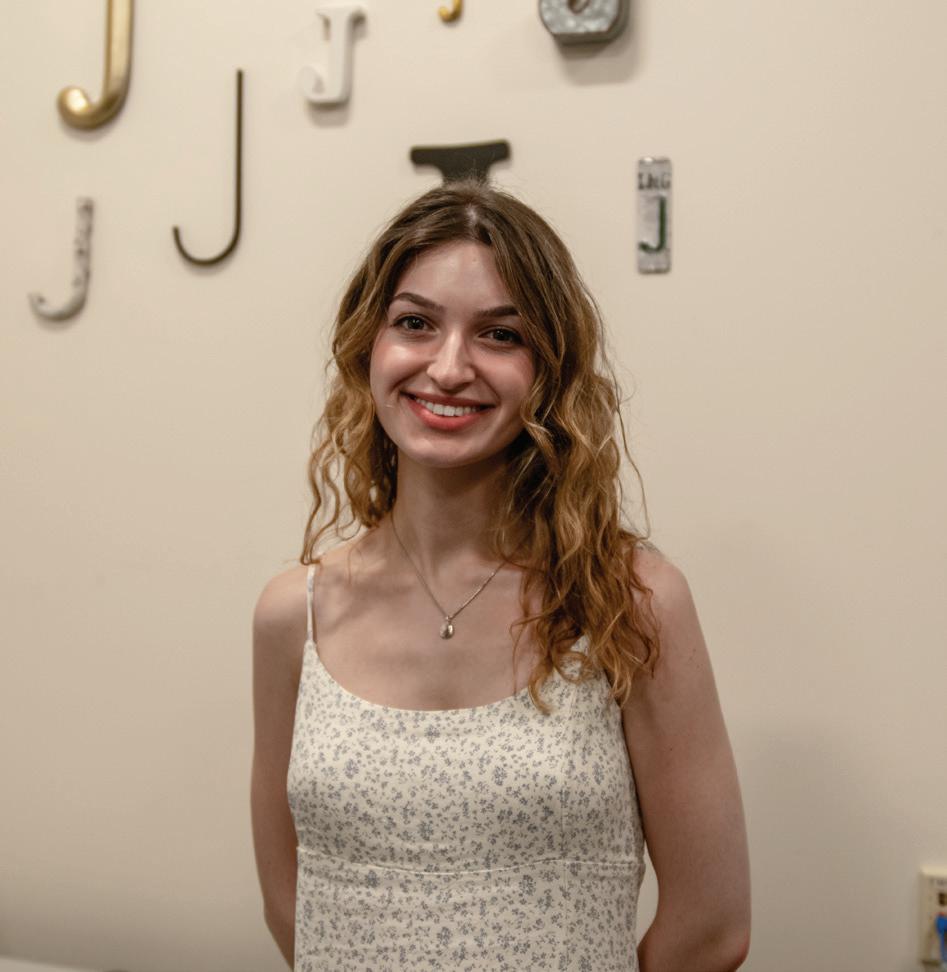
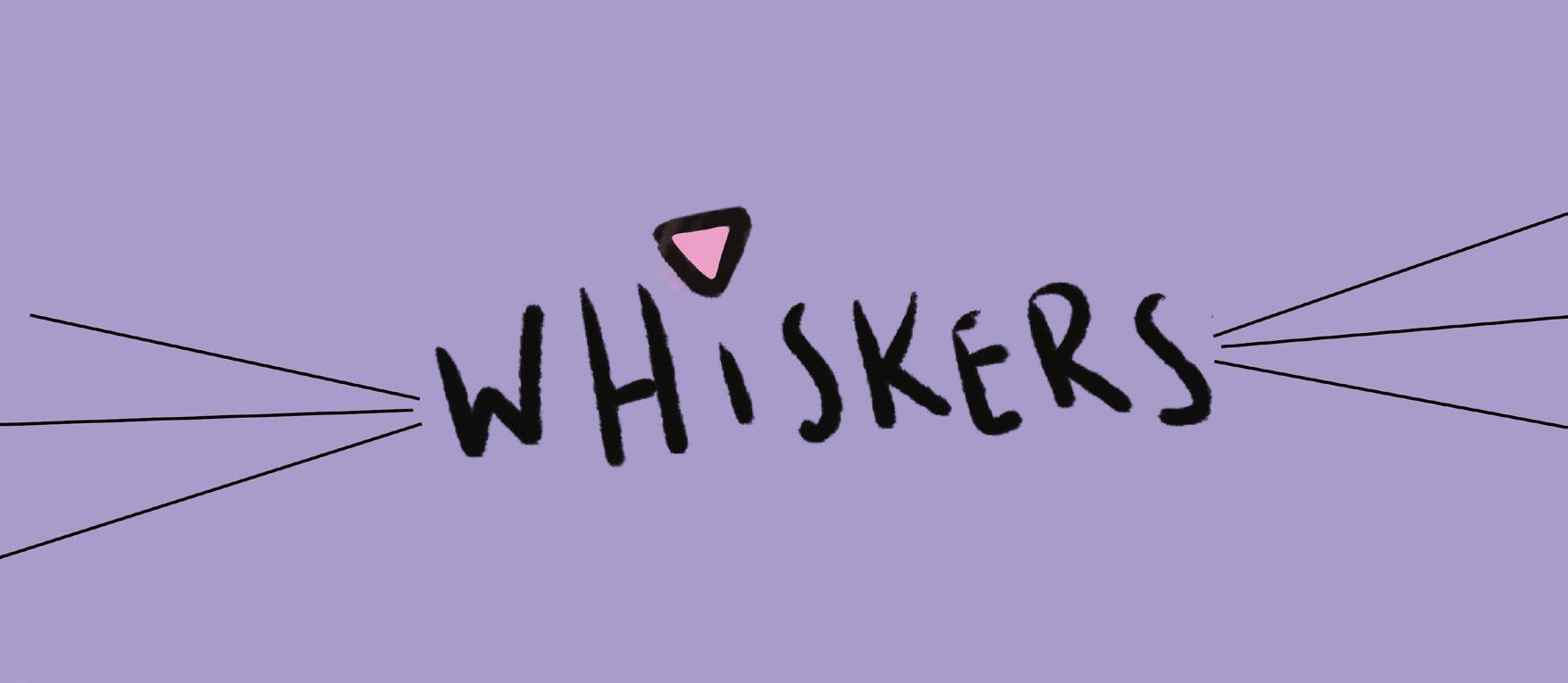


Down
1. Payment for a service.
2. Famous for his “Midnight Ride” during the American Revolutionary
18. Functional Requirements Document. (acronym)
20. What models do.
22. Charlie Brown kept getting this stuck in a tree.
24. Every individual.
25. Hard but easily breakable.
26. Spooky month.
27. To foretell an event, good or bad.
31. Naked.
32. Added to dough to make it rise.
34. Facial accessory of a pirate.
36. Under the weather.
40. Wild grass used to feed horses.
42. What Bambi’s mother is.
44. Brand of soap.
45. Opposite of close.
46. Headquarters of the United States Defense Department.
50. A greeting.
51. The amount of space inside shapes.
52. A feeling of personal identity.
53. Electric Vehicle (acronym).
54. Mamma ____! Here we go again.
55. Squirreling away.
56. Fleming, soprano.
57. “____ tu, Brute?”
58. Argue.
60. What is uploaded onto YouTube (abbre viation).
61. Holds a plant up.
By DALIANA78. Katniss’ best friend from District 12.
81. “Monsters, _____.” from Pixar.
82. Exclamatory after you hurt yourself.
84. Founder of the Russian Communist Party.
85. The “p” in mph.
86. System for connecting many computer systems in a local area network.
87. One of these will rule them all and, in the darkness, bind them.
65. Not before.
66. Hang over from age or wear.
67. Land mass surrounded by water.
68. Gotta scratch it.
69. Protagonist of the “Kung Fu Panda” franchise.
71. ____ Nas X.
72. International Standard Name Identifier (acronym).
73. Epidermis.
75. Untruth.
76. Treebeard from “The Lord of the Rings.”
79. College-level tests available for high schoolers.
82. Sitting atop.
83. “______ are the champions, my friends.”
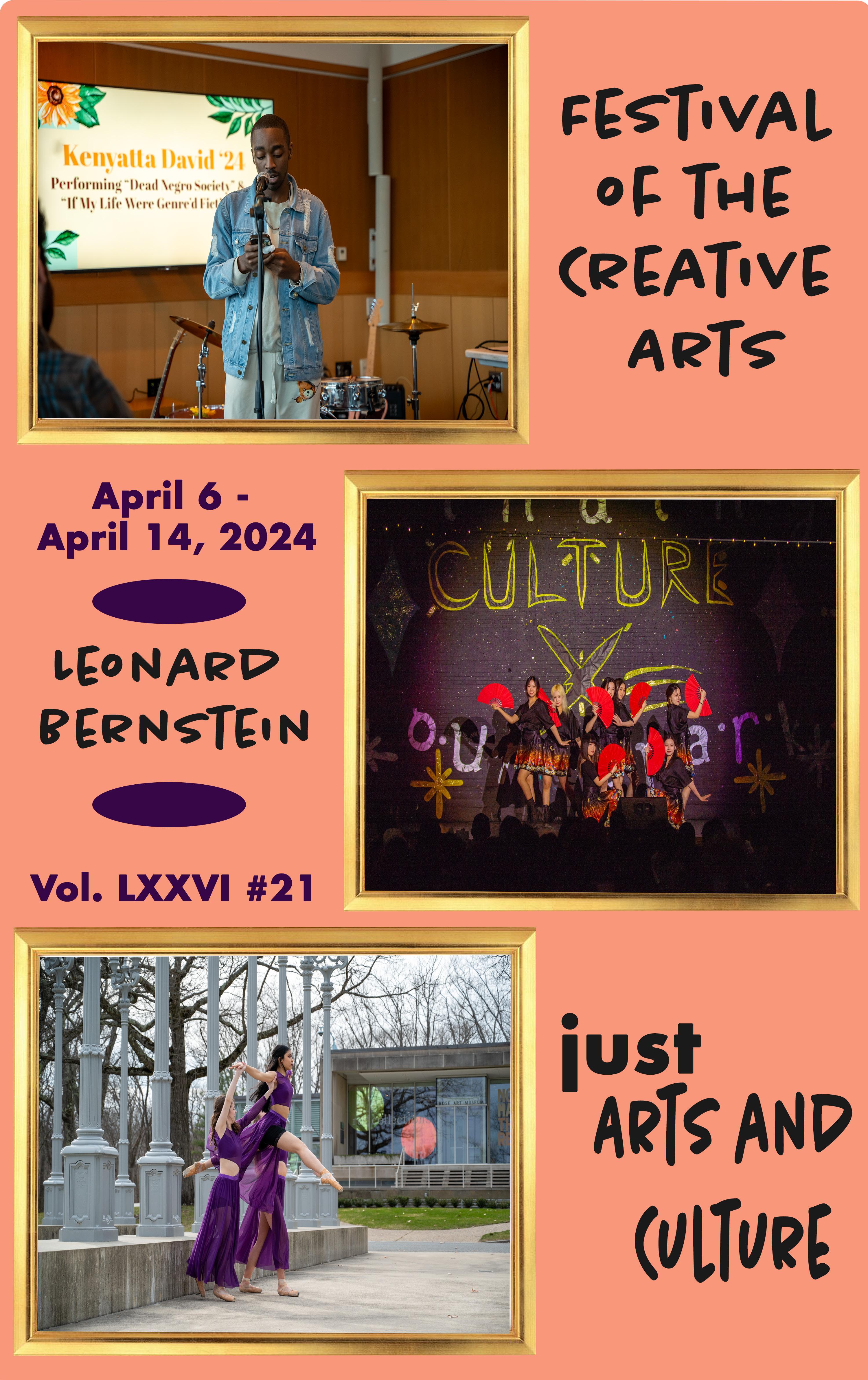 Design: BRYAN WOLFE/The Justice.
Waltham, Mass.
Photo: GIANNA MORALES/The Justice.
Photo: SKYE ENTWOOD/The Justice.
Photo: GIANNA MORALES/The Justice.
Design: BRYAN WOLFE/The Justice.
Waltham, Mass.
Photo: GIANNA MORALES/The Justice.
Photo: SKYE ENTWOOD/The Justice.
Photo: GIANNA MORALES/The Justice.
The afternoon of Wednesday, April 10, greeted the trio of dancers — Grace Delaney ’26, Carrie Wong ’27, and Irina Znamirowski ’24 — with clear skies and brisk breezes. Community members stood before the Lights of Reason, all holding their breath in anticipation. The trio waited for the music, their purple skirts billowing in the gentle winds. What started as a disaster turned into an opportunity to choreograph something unforgettable. Earlier in the semester, Irina had taught her dancers “Danse des petits cygnes” from the ballet “Swan Lake.” After teaching the routine, Znamirowski lost two of her dancers. The
choreography requires four ballet dancers to perform en pointe, and Znamirowski was left with only three, including herself. The variation just would not be complete without a fourth dancer.
Znamirowski has faced countless scheduling and rehearsal challenges throughout her ballet career, and she was not going to let this small dilemma stop her from showcasing a pointe dance. She used this opportunity to choreograph and perform a contemporary pointe dance to Isak Danielson’s “Bleed Out” with Delaney and Wong. It was originally disappointing for Znamirowski and her group that they could not per-
form their original piece — and that two of them were not able to perform at all — but the final product was so breathtaking, no one would believe the dancers had not had all semester to rehearse.
The music filled the spring air with soft piano chords. The notes weaved between the dancers as they moved together through piqués and arabesques in delicate unison. Before the chorus, Wong jumped up between the Lights of Reason and leapt off in a saut de chat, with Znamirowski and Delaney lifting her. The music swelled and the chorus swept the dancers legs into developés and melted their backs in slow cambrés. The dancers
performed countless steps en pointe, balancing on the tips of their toes atop cold, hard concrete. Wind swept through their costumes of lycra and tulle as they moved, their half-up, half-down hair fluttering with every gust and leap. Delaney, Wong and Znamirowski performed the dance three times, every repetition even more stunning than the last. Each time, as the music fell silent and the dancers stilled, the audience around the Lights of Reason — with an additional audience outside the Spingold Theater — burst into applause. The performance wasn’t what anyone expected — it was even better.

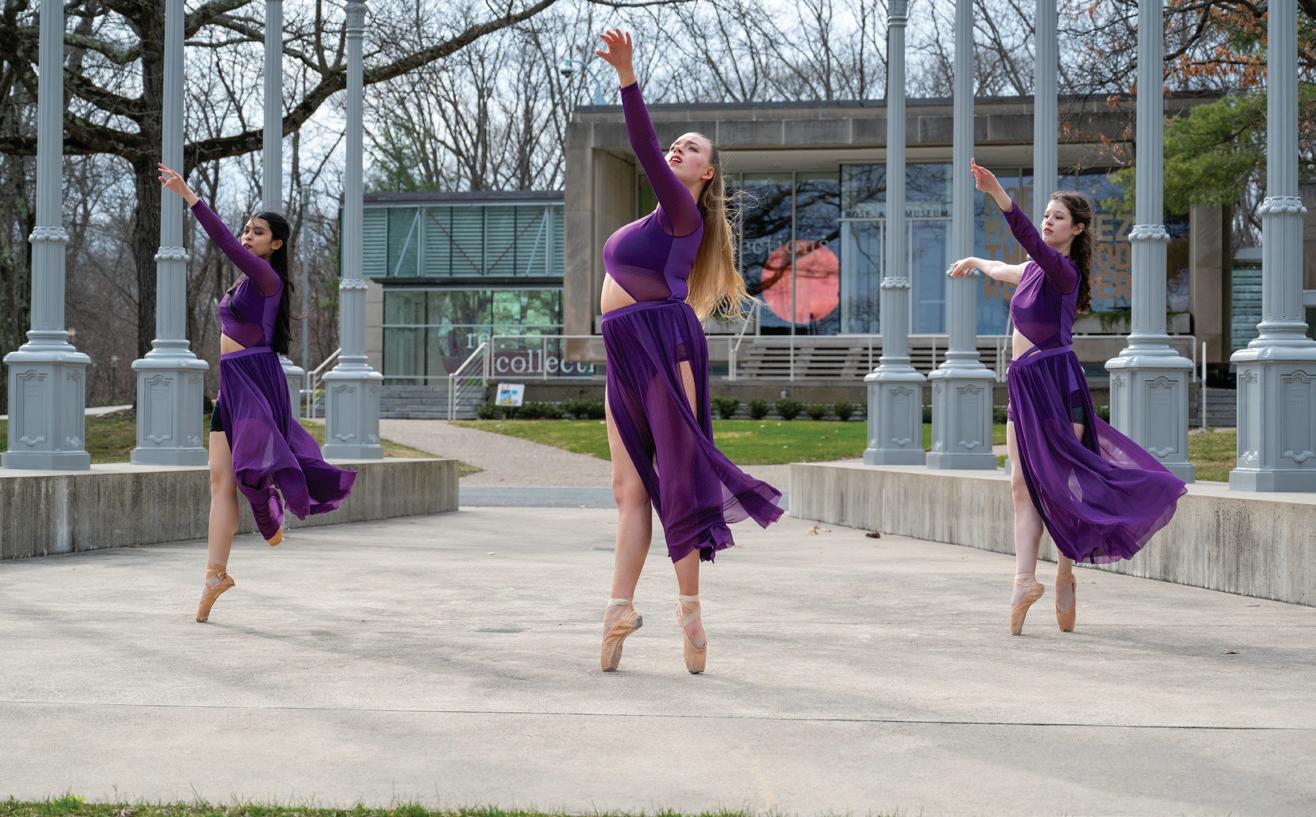

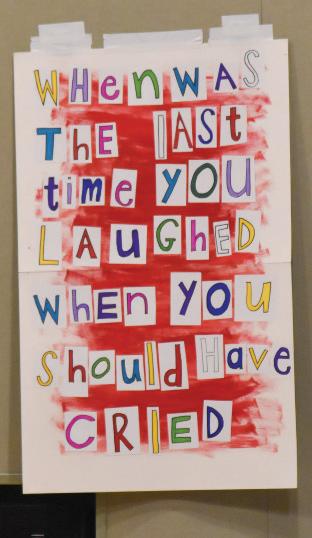
Comedy has an incredible power to help us navigate some of the most complex and emotionally taxing experiences. A moment of genuine laughter can lift spirits, foster unexpected connections and create a space for people to escape and face the challenges of life. In her onewoman performance, put on in conjunction with the Leonard Bernstein Festival of the Arts, Brandeis alum Zoë Rose ’20 used her humor for the very purpose of inspiring audiences to look inward.
During her time at Brandeis, Rose’s knack for comedy and creativity was evident in her involvement in To Be Announced, a Brandeis student improvisation group, as well as her perusal of a minor in Creativity, the Arts and Social Transformation. In fact, her one-woman show, “Zoe Rose Spills her Guts,” originated as her senior project for the CAST minor. Given this background, it is no surprise that Rose’s show struck a balance between social con-
sciousness and art.
In her one-woman show, Rose switched between four different incredibly human and humorous characters. First, she impersonated a socially competent and respectful frat boy. Her portrayal of this character was goofy and fun-loving, especially as she handed out free beers to audience members who were over the age of 21. However, she also highlighted the consciousness of the frat boy, as he had genuine respect for women’s boundaries.
Her second character was a British girl head over heels for a fictional character named Greg who she “has wanted to peg” for the longest time. Rose brought a ton of energy to this role, from her choice to begin tap dancing for the audience to waving a sign that simultaneously called for audience applause and stated “FUCK GREG.” For Rose, the eccentricity and chaotic nature of this character connect to a deep frustration with navigating love and life in one’s 20s.
Rose’s show then took a slightly darker turn when she switched to playing a troubled clown struggling with drug abuse. Unlike her previous character who begged for audience attention and engagement, Rose simply ignored the crowds, crafting a concoction of alcohol, pills, cigarettes and glitter. In this moment, Rose uses the absurd to ease the audience into conversations about sensitive and complex topics. After previously drawing the audience in with fun-loving chaotic characters, Rose uses the earned attention to begin tackling more meaningful topics.
Rose’s fourth and final performance was not of any character, rather it was an authentic, vulnerable representation of herself. She turned her own diary into her script, sharing entries from ages 14 to 21. Rose opens up about her troubled sex life and struggles with food, struggles not uncommon to individuals in this age group, but rarely openly discussed.
In closing out this rollercoaster of a show with such a raw exposure of herself, Rose not only encourages audiences to be more self-reflective, but demonstrates the profound power of comedy to dismantle our strongest metal blocks.
In her conclusion of the show, Rose asked that the audience attempt to do the same internal work comedy helped her do. Posted on the walls of the performance space were diary prompts such as “When was the last time you laughed when you should have cried?” and “When was the last time you overindulged to the point of self-destruction.” Although these prompts are simply for private reflection, Rose asks a lot from her audience through these hard-hitting questions. In using comedy, Rose attempts to break down the emotional and mental walls we build and encourages viewers to dig through the rubble and understand their inner truths.




